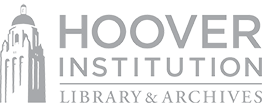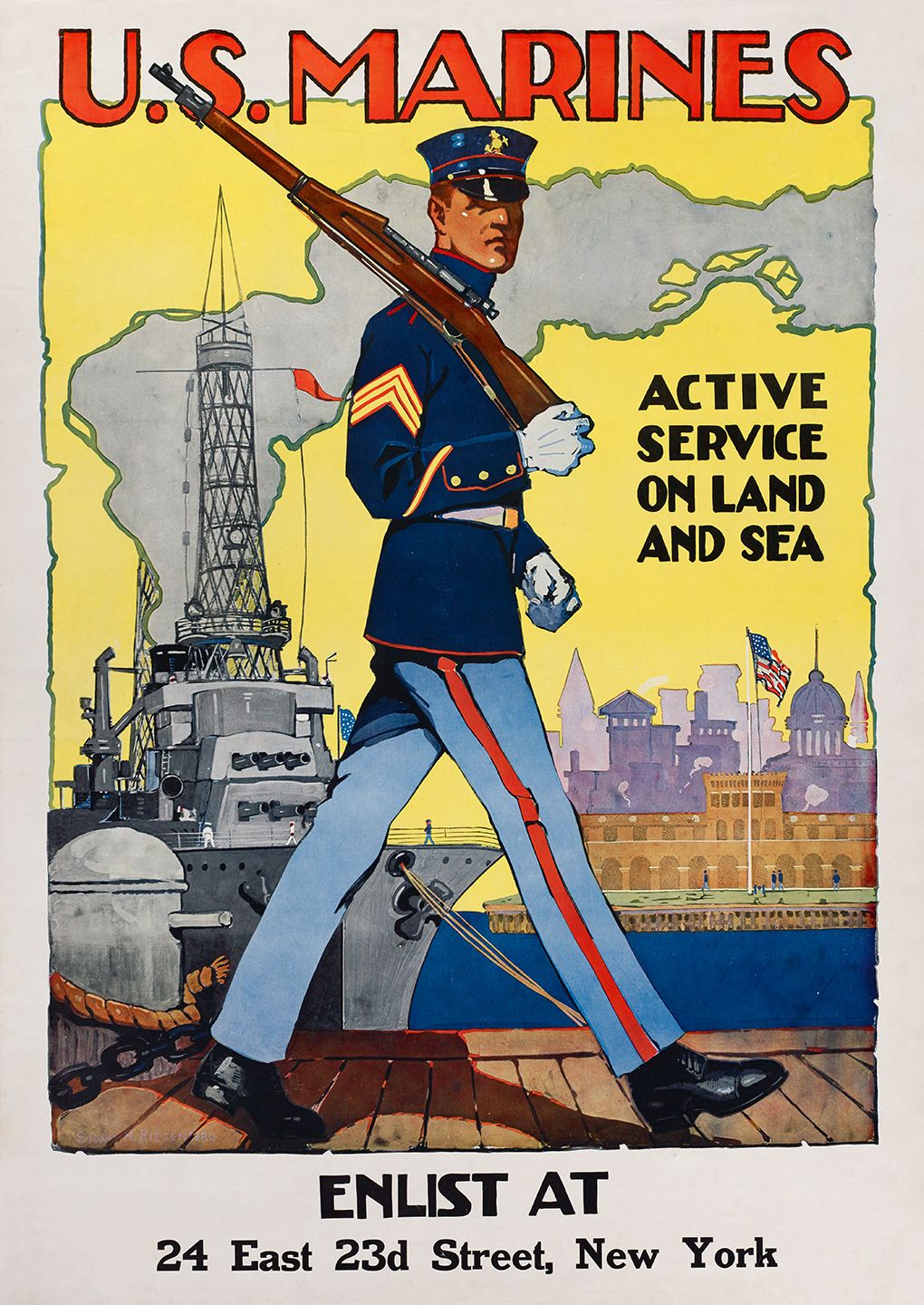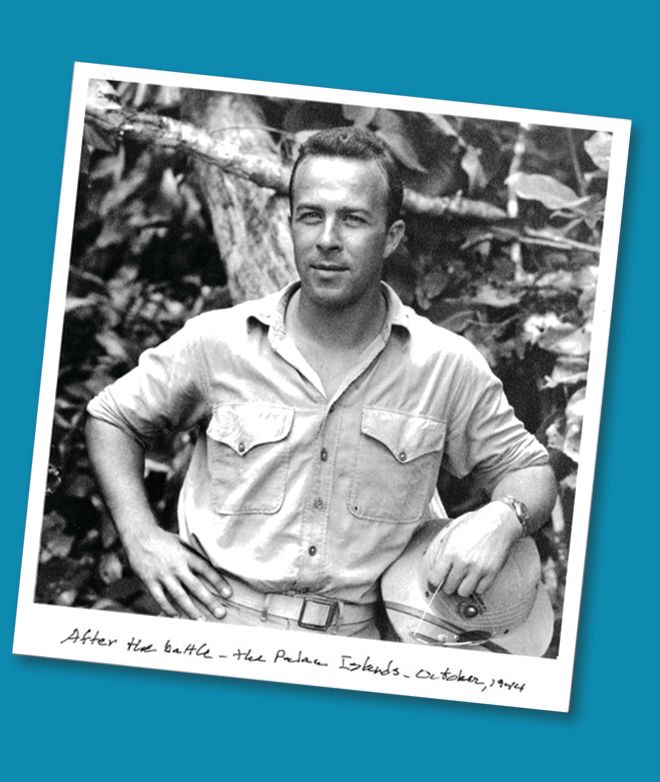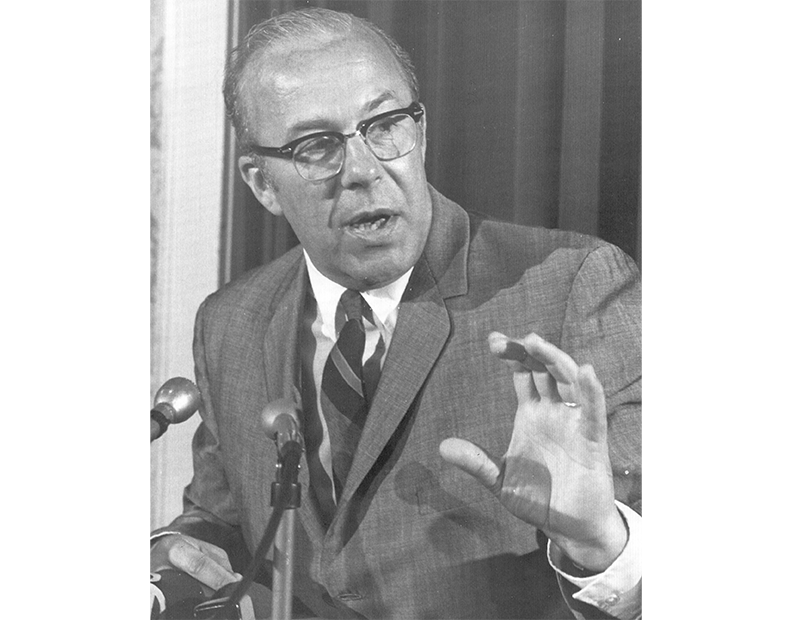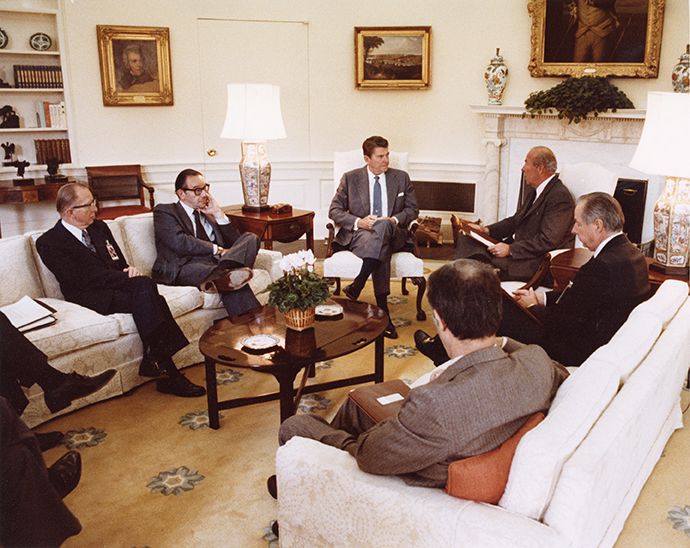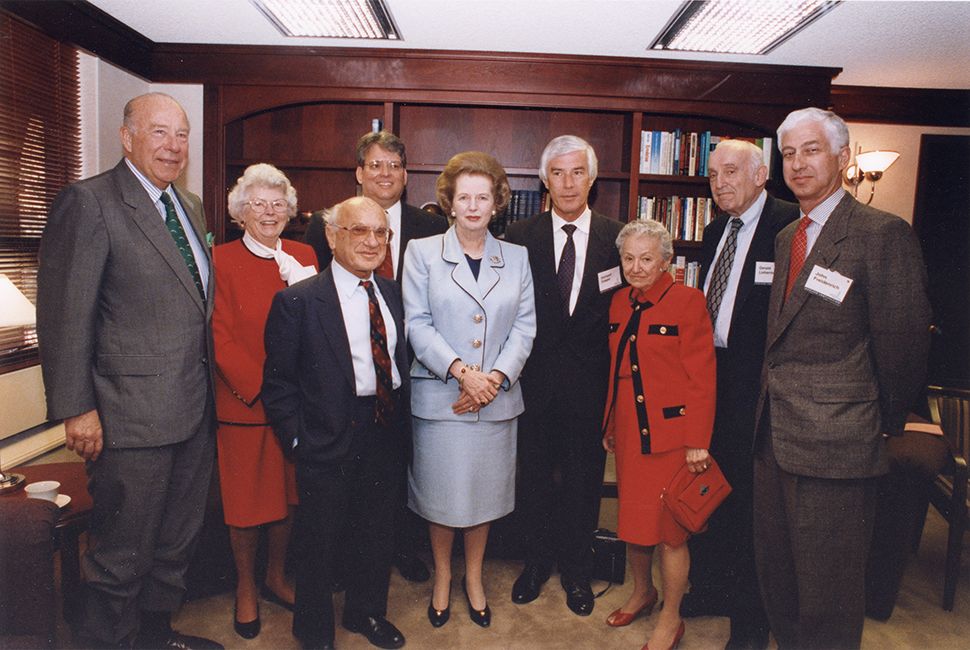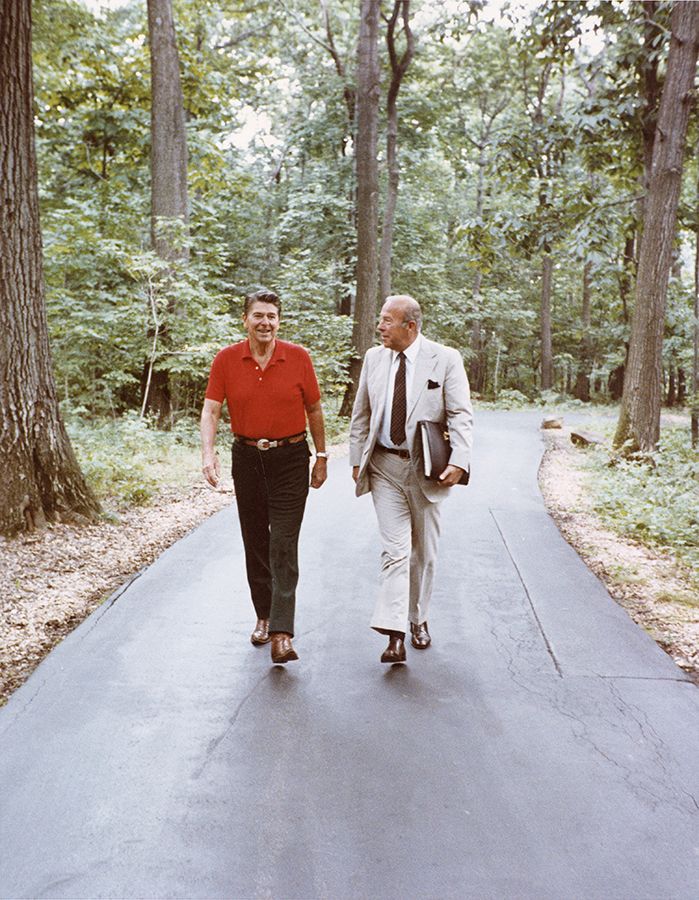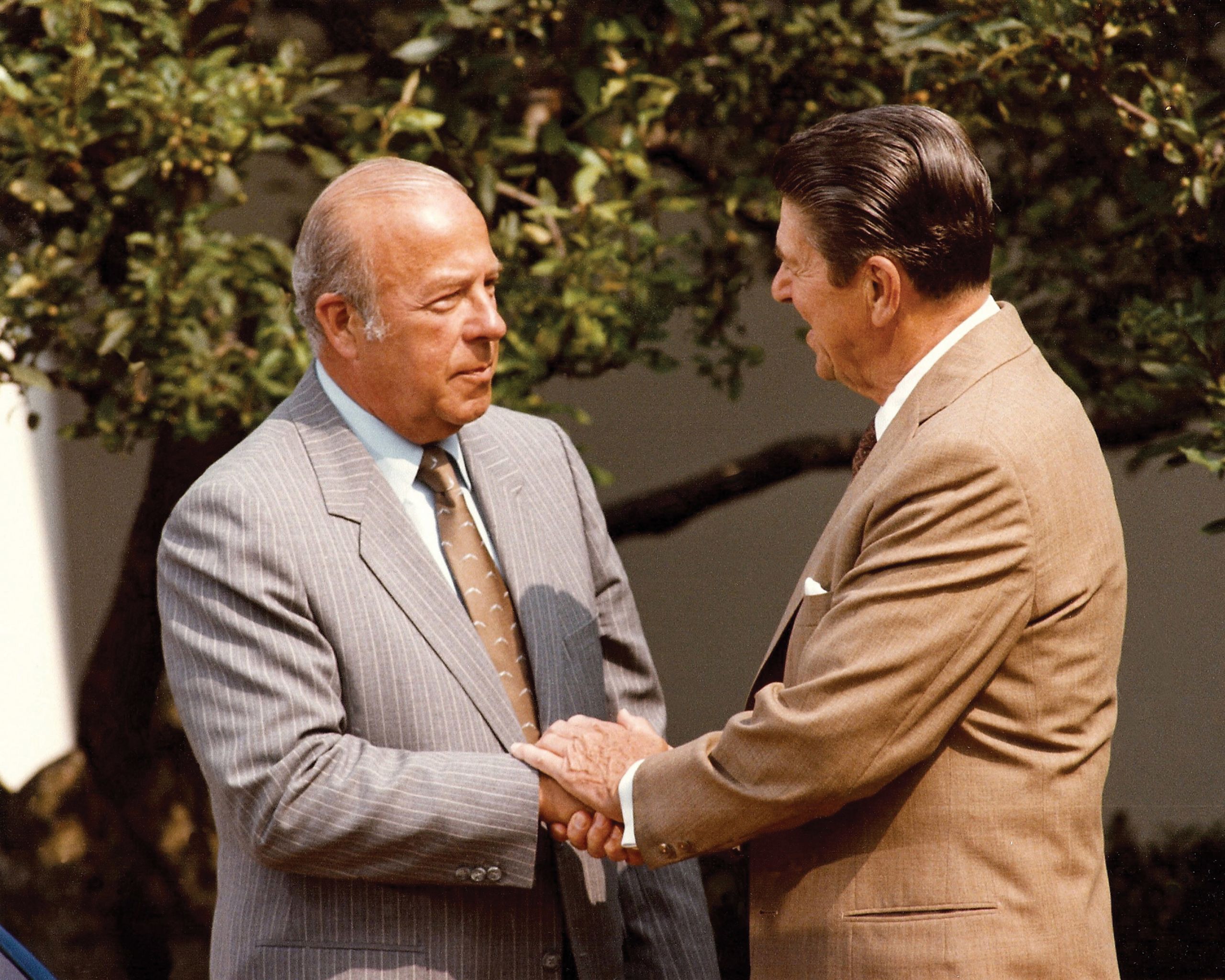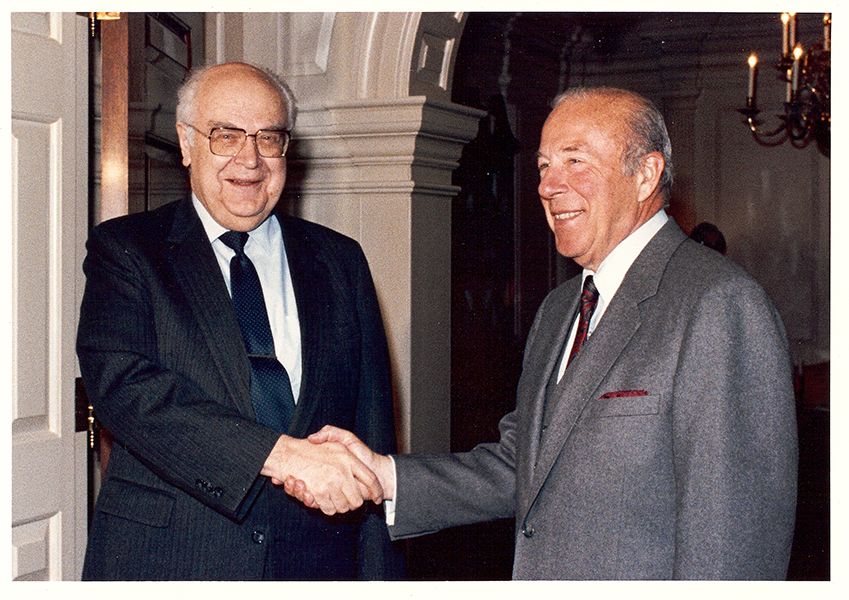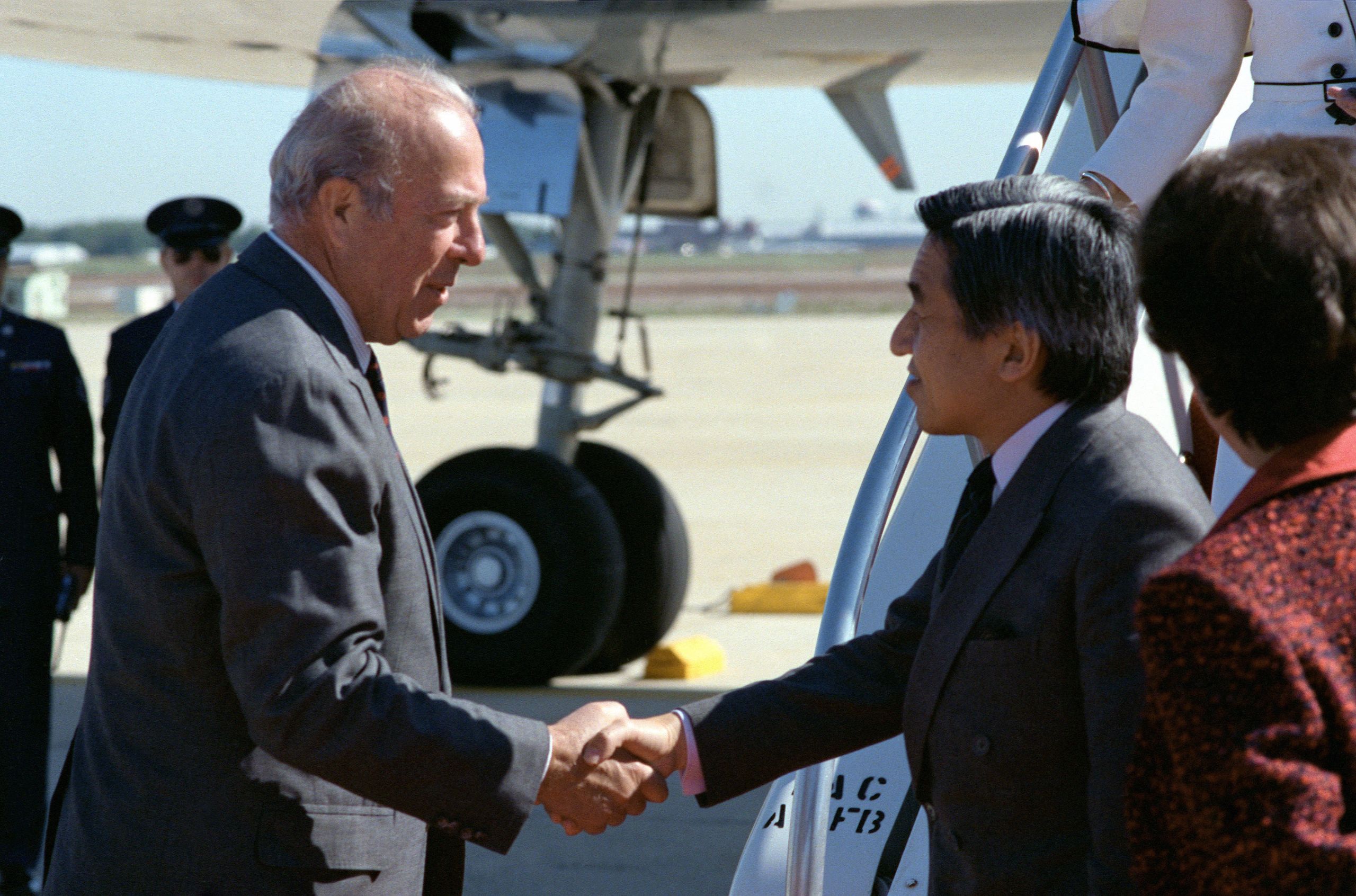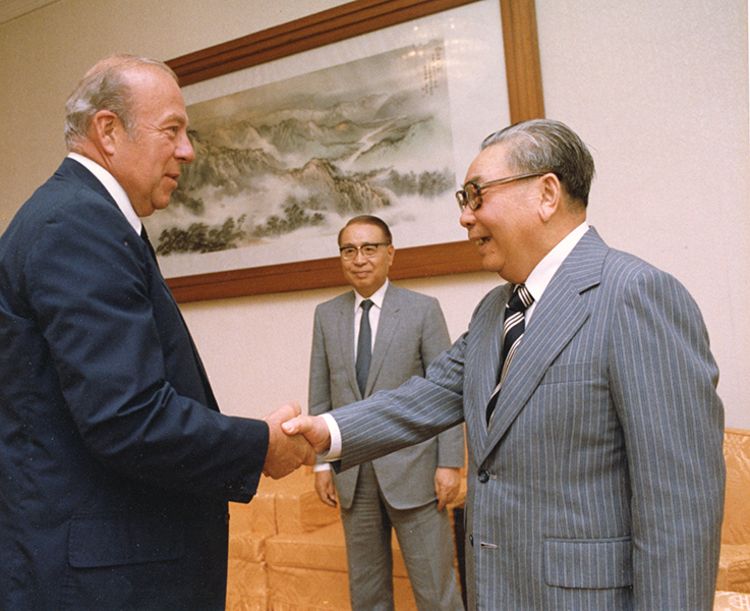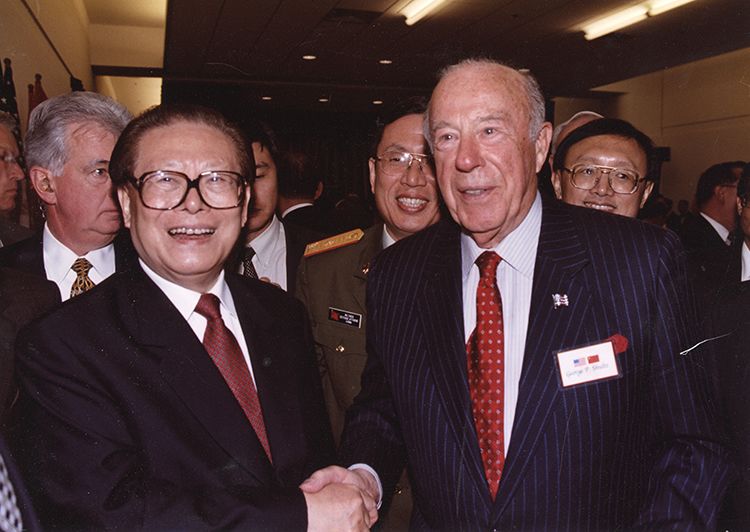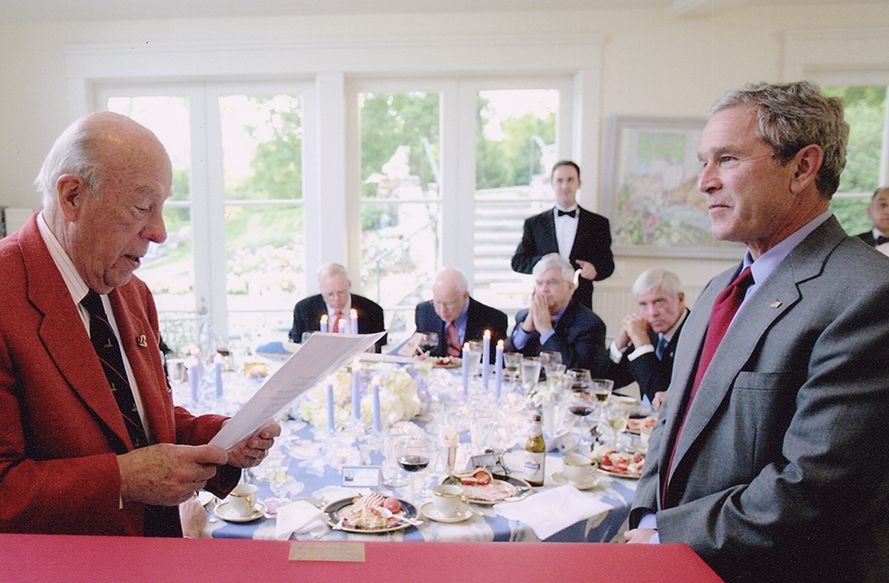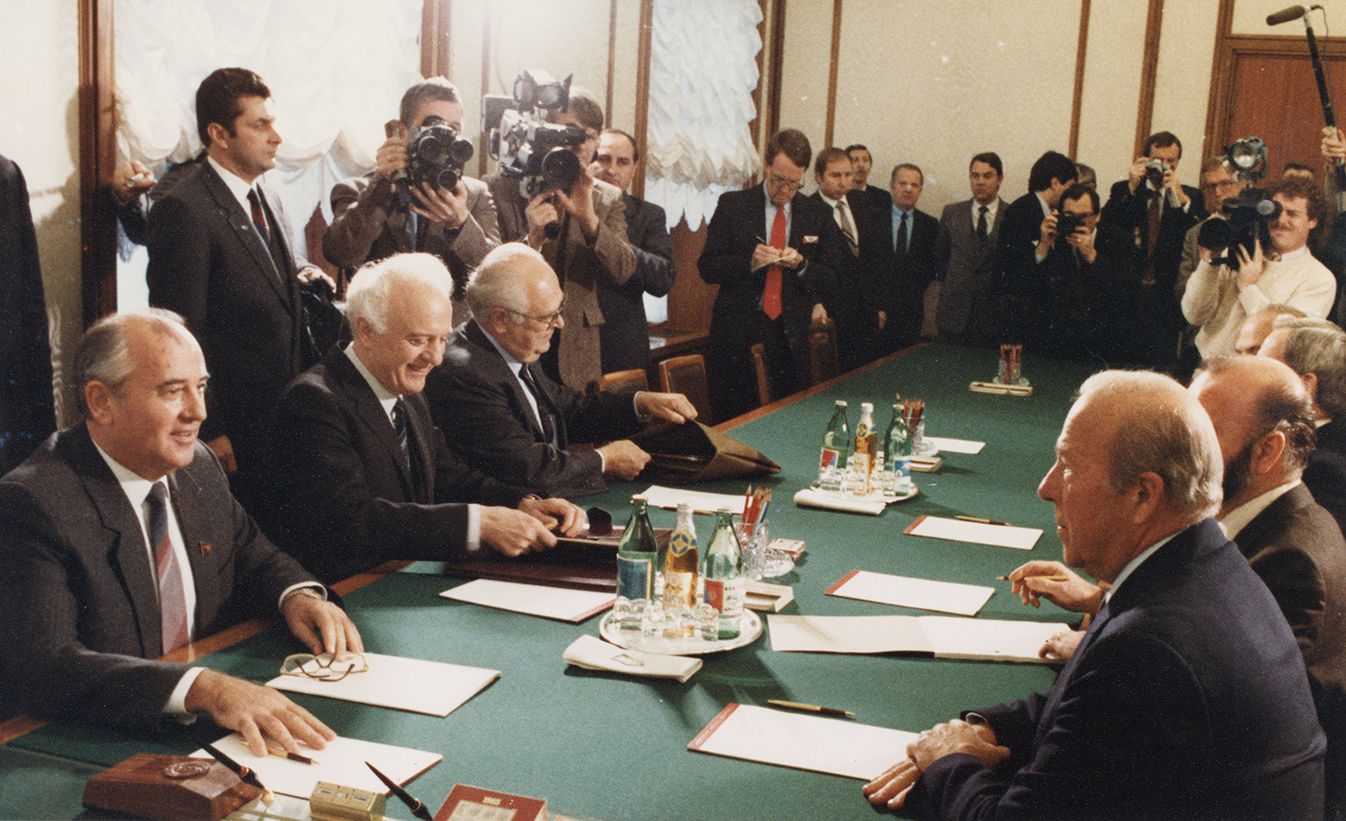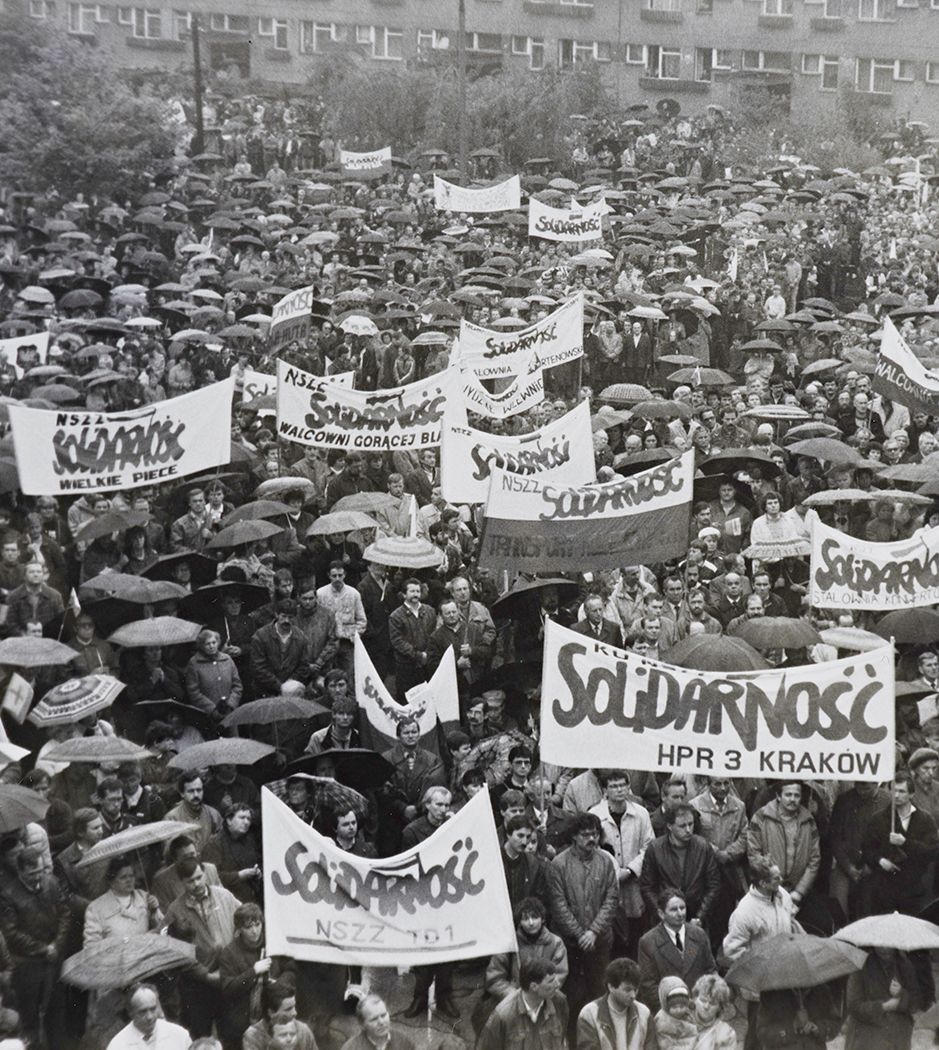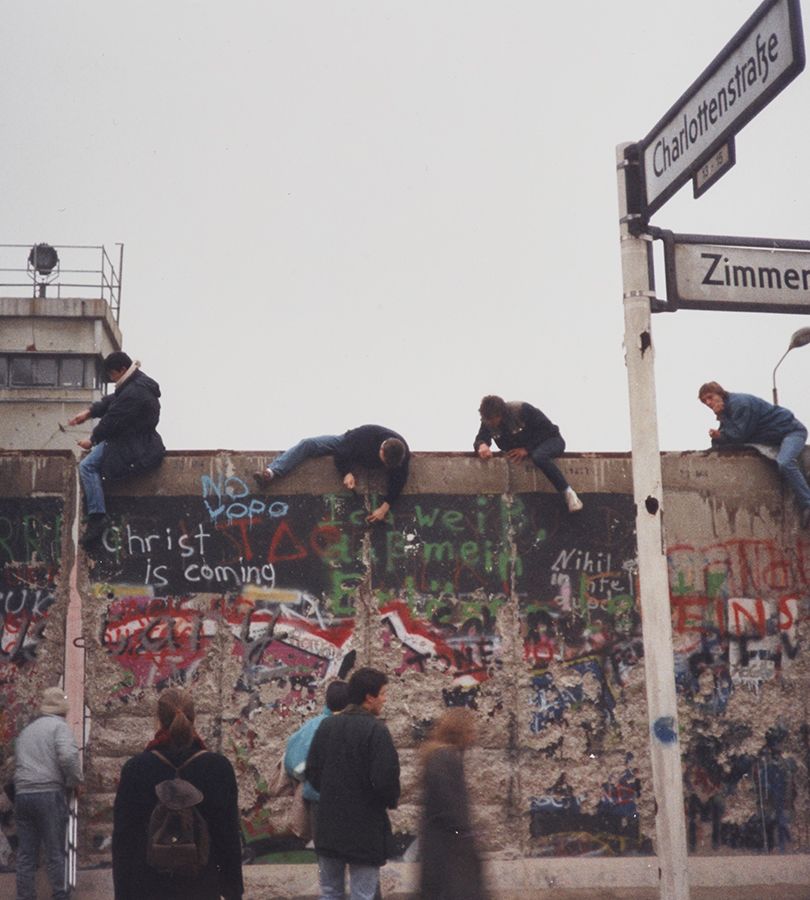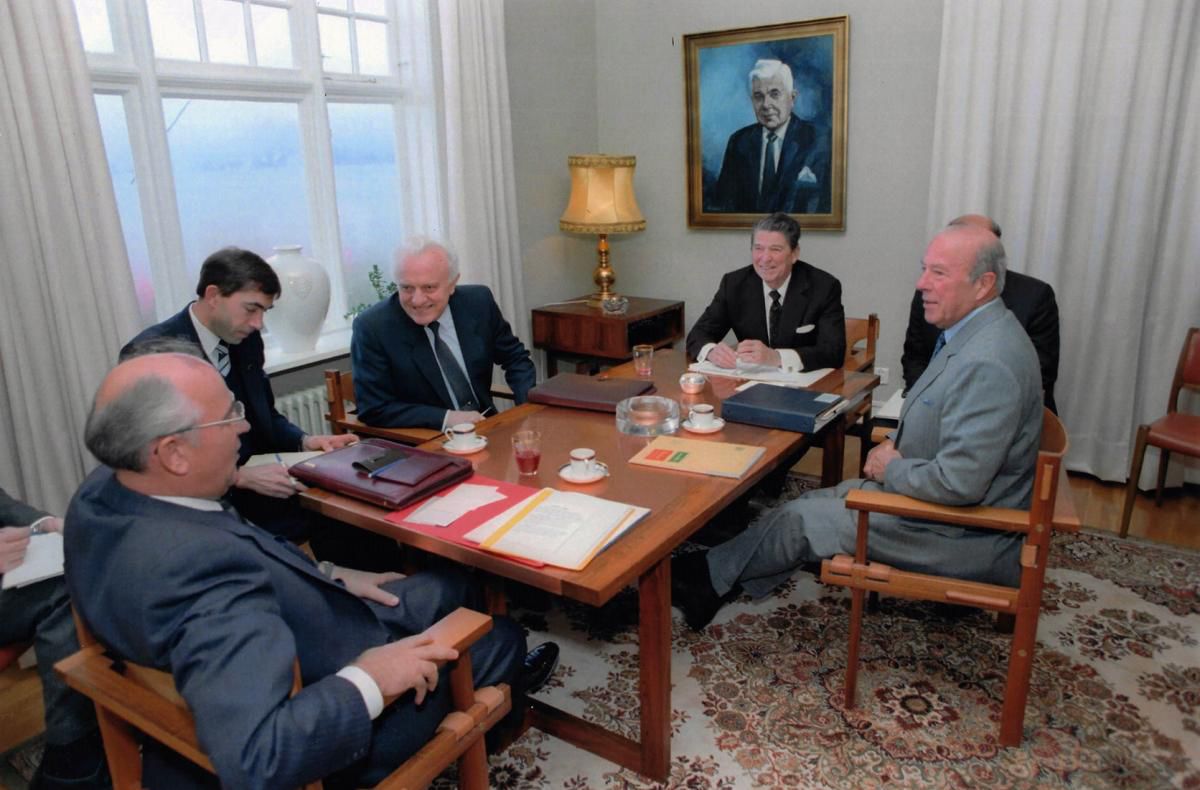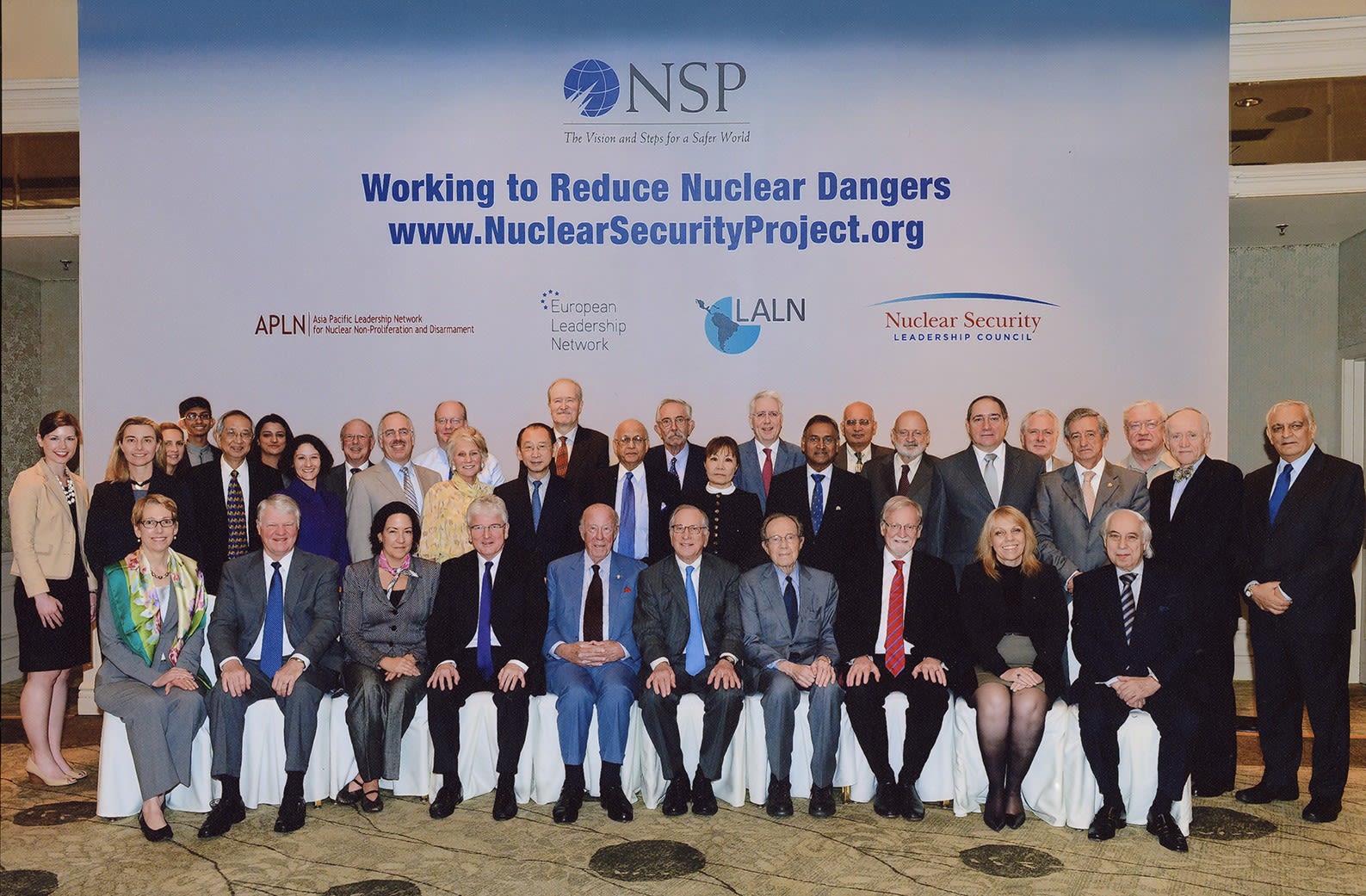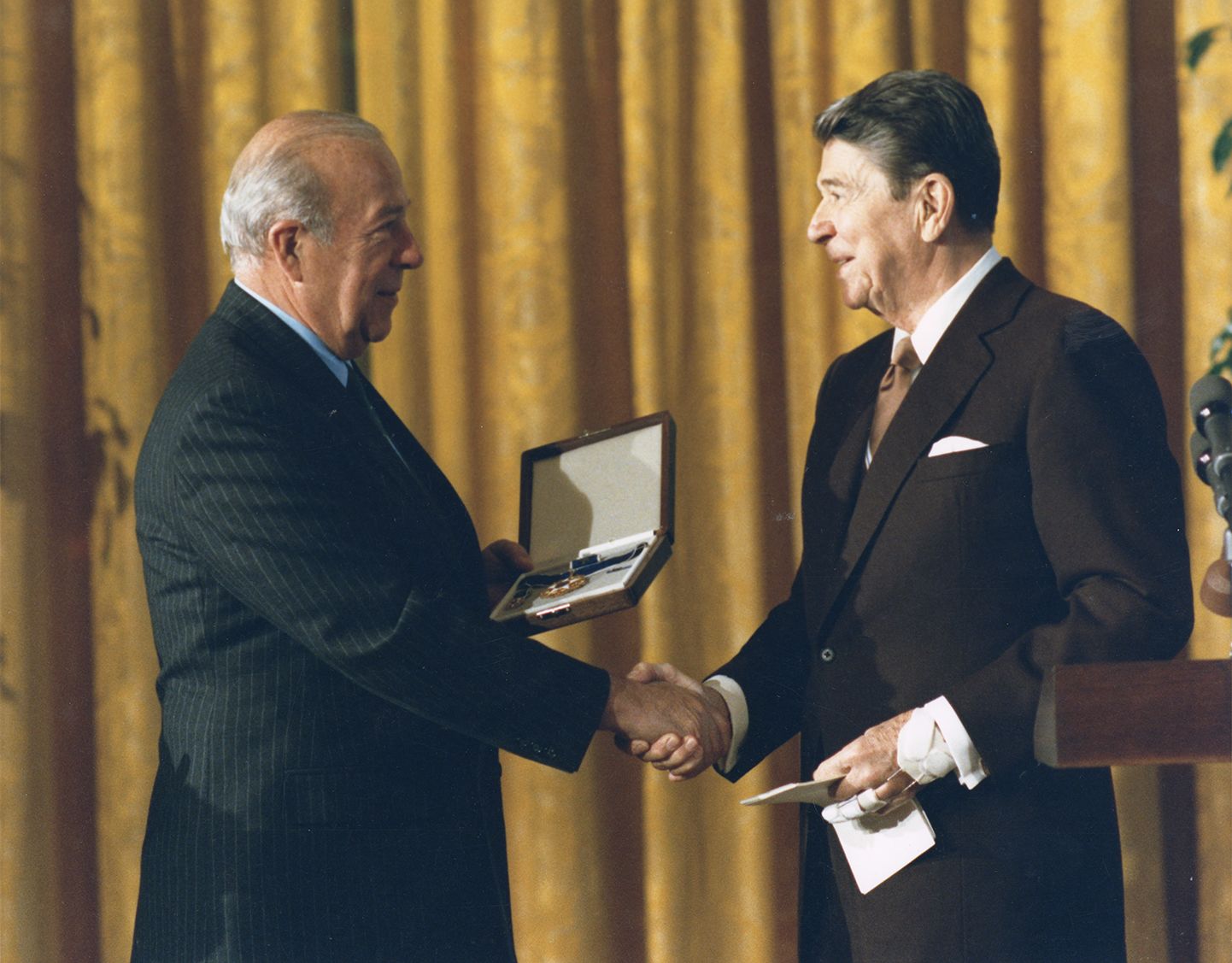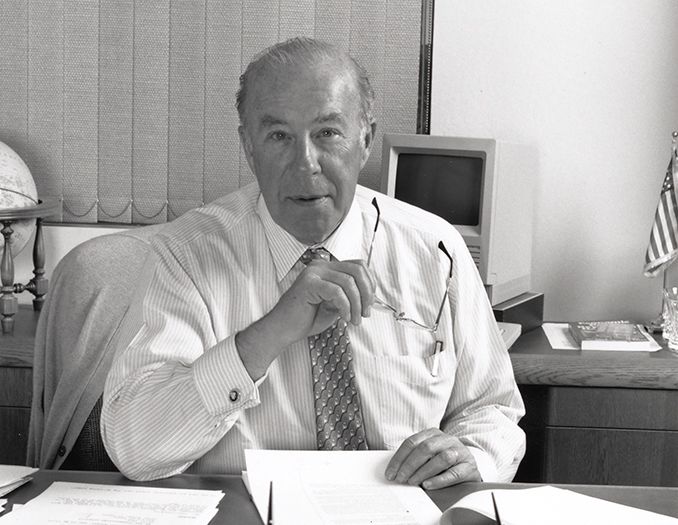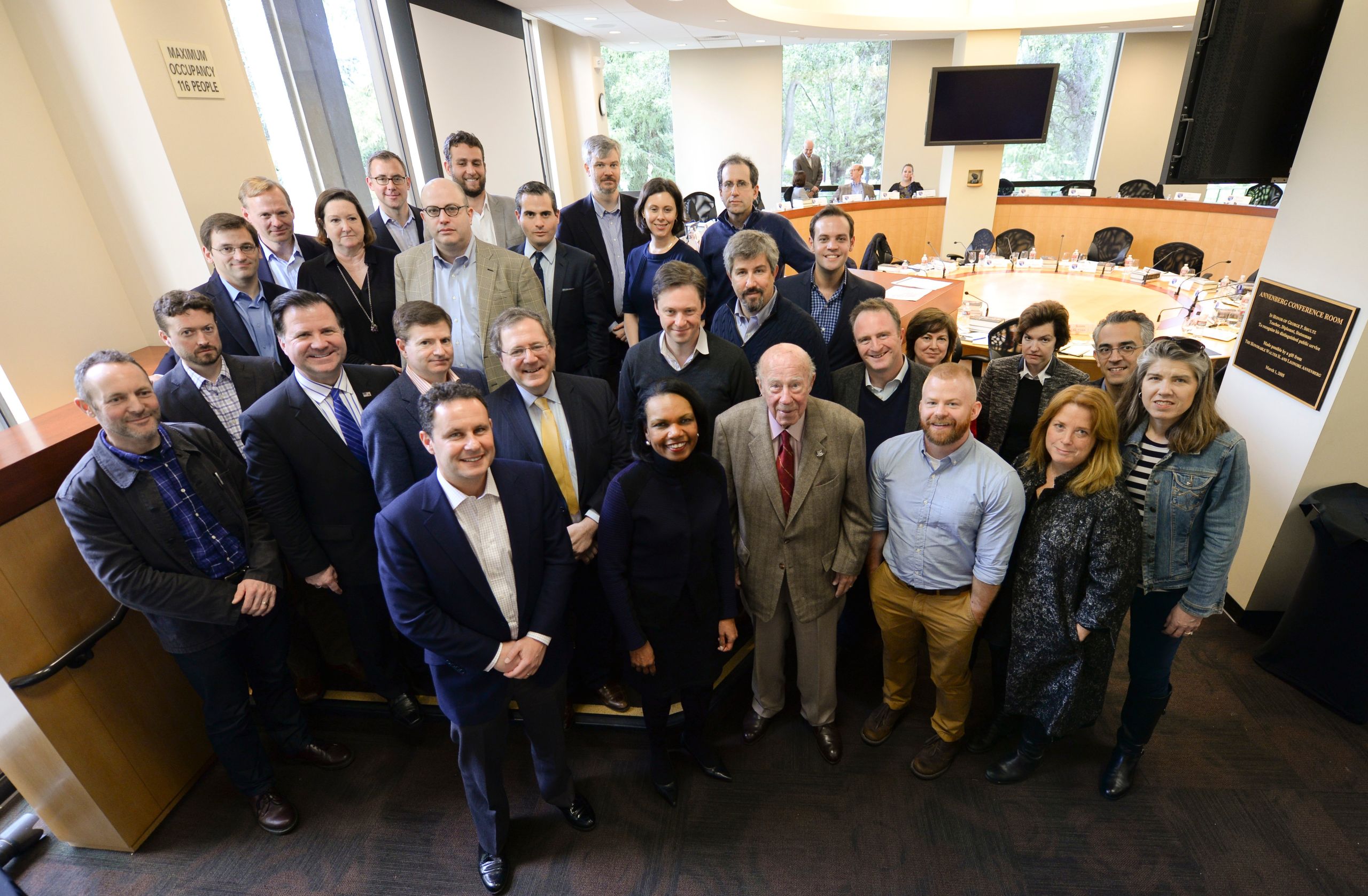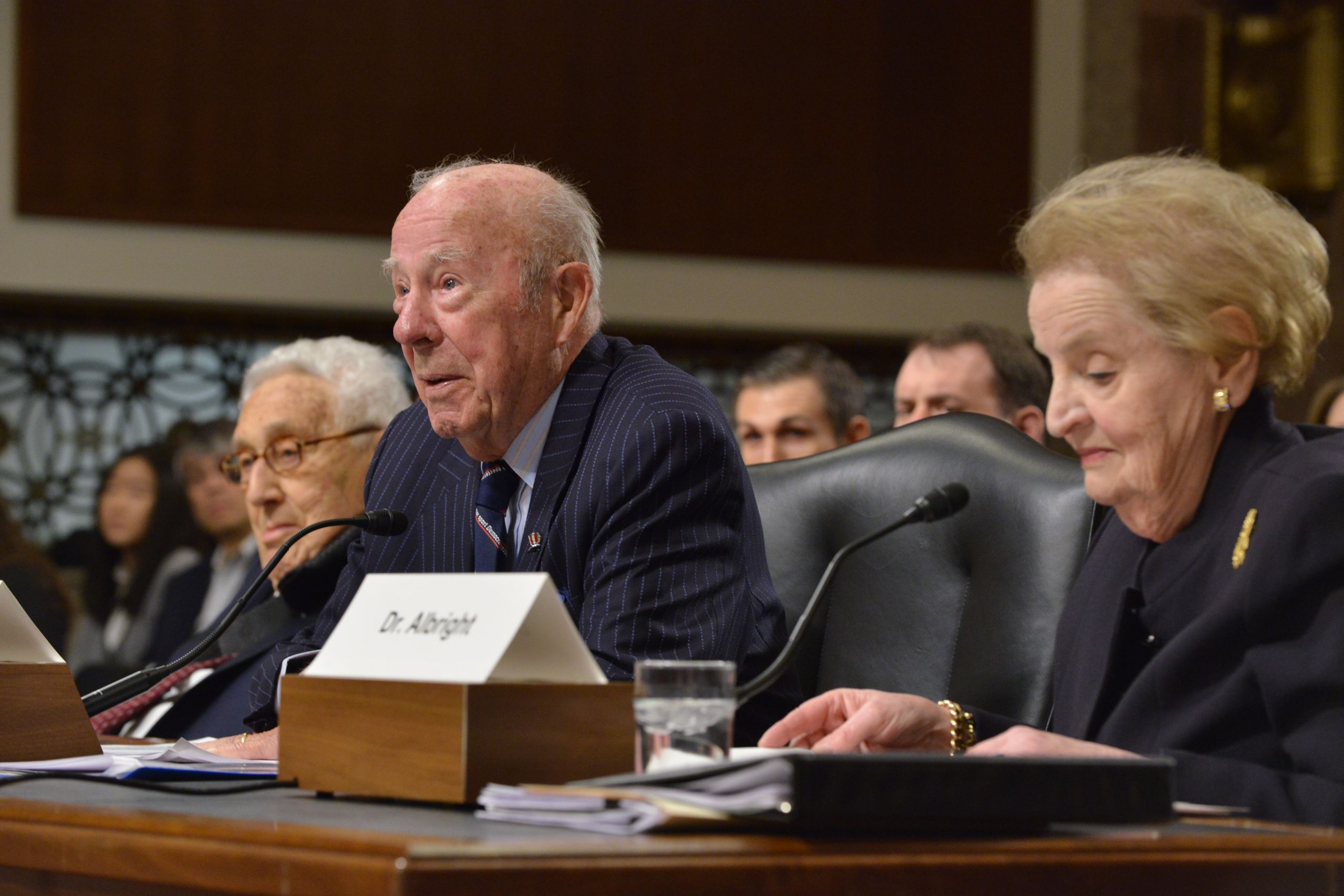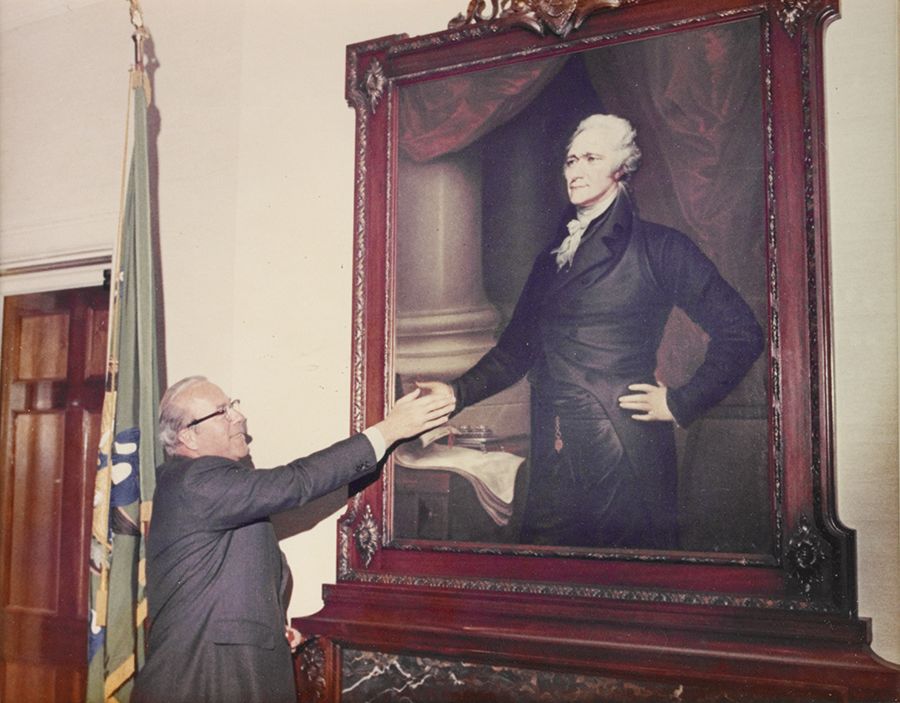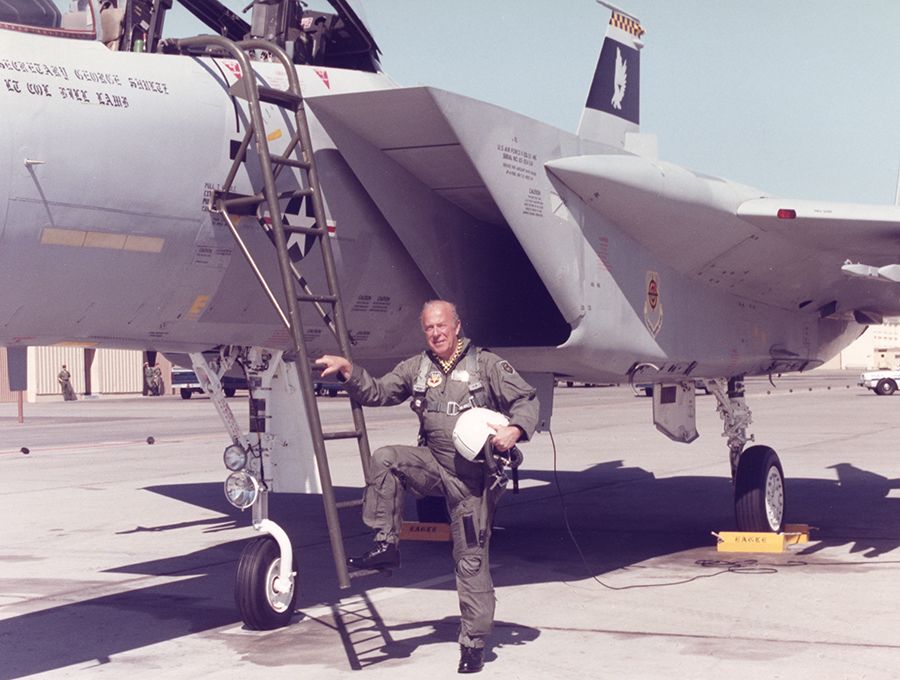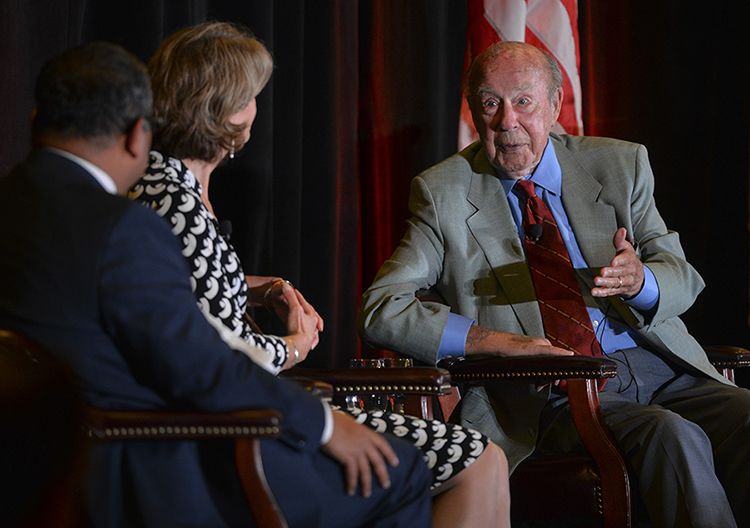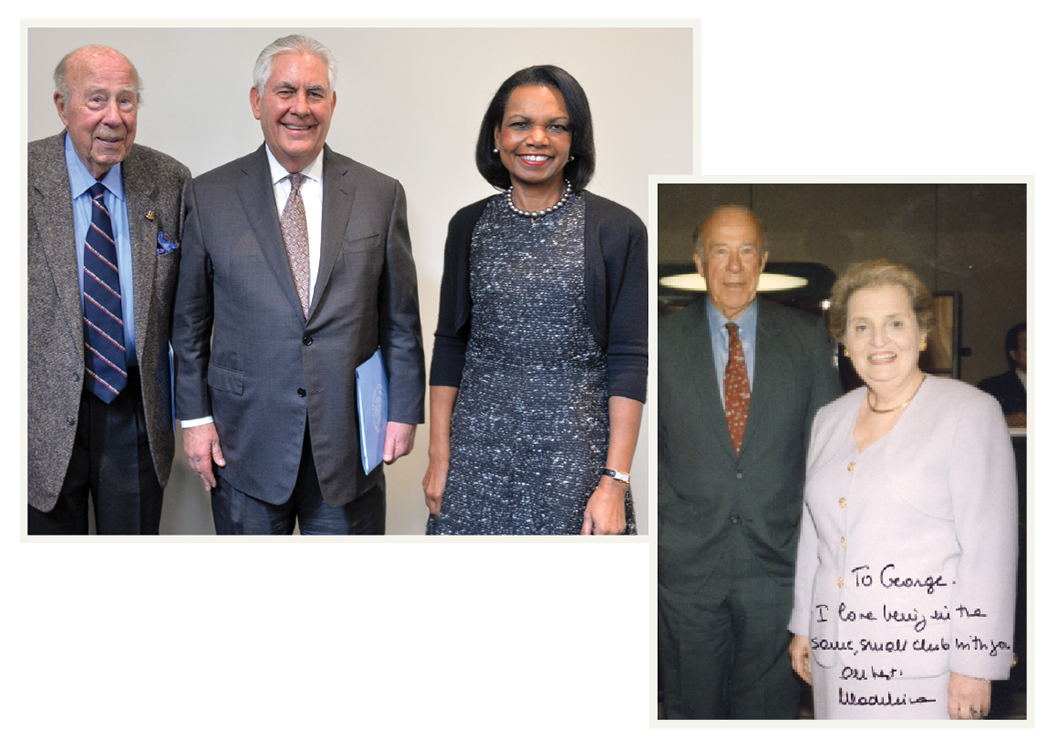On the Record
Life Lessons from
George P. Shultz
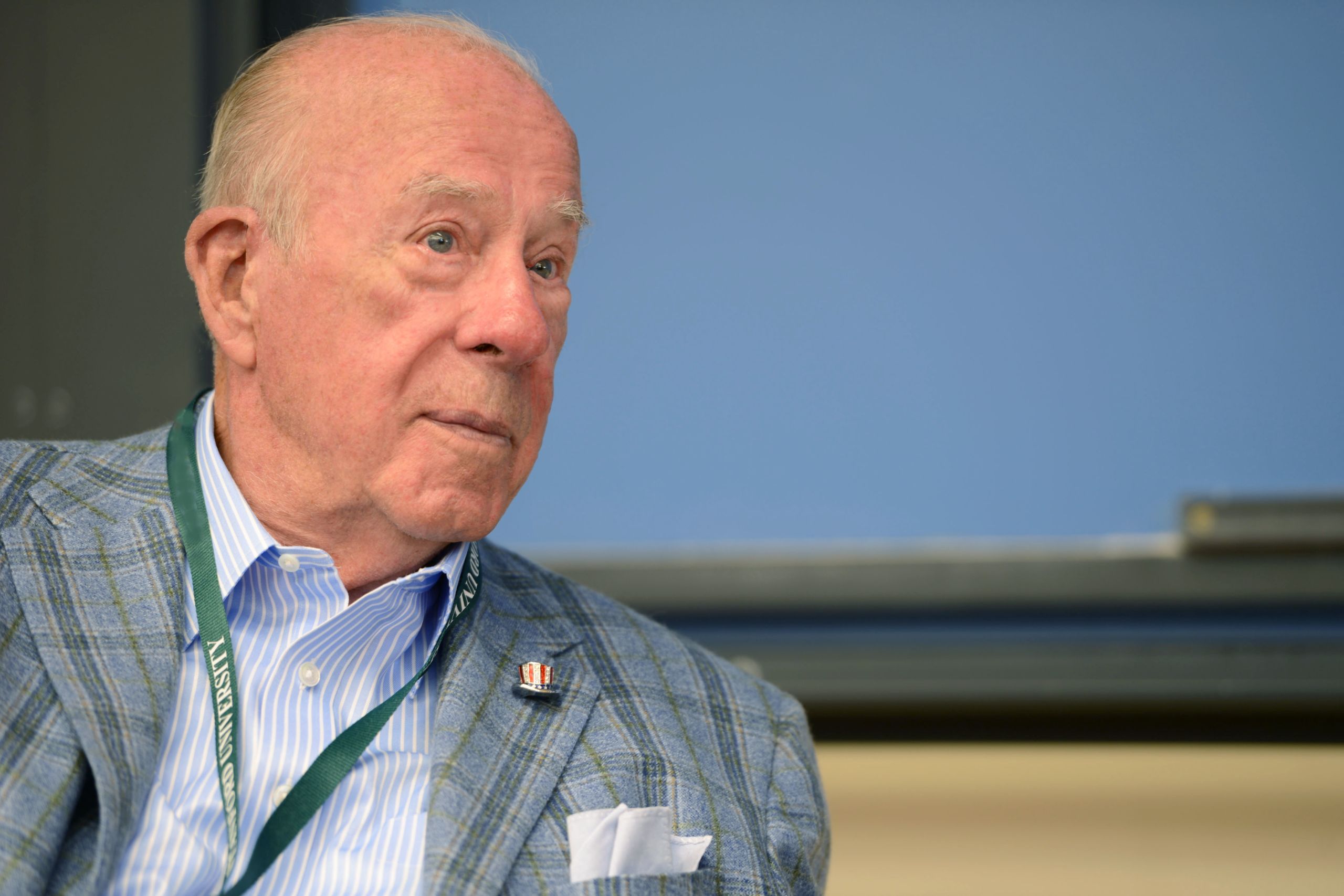
George Pratt Shultz (1920–2021) was the Hoover Institution’s Thomas W. and Susan B. Ford Distinguished Fellow. He was an indelible thinker who drew from his experiences as an academic economist, a business executive, and a lifelong public servant to pursue the practical policy measures needed to ensure freedom and a better life for people around the globe. He answered his nation’s call for service for over 75 years, from his time in the Marines during World War II to his work alongside Ronald Reagan as Secretary of State to end the Cold War peacefully.
Secretary Shultz continued to influence public policy and impact world events through his role as a Hoover Fellow and a candid adviser to world leaders. He was known as a straight-shooter who held accountability and trust in the highest regard. To honor the remarkable legacy of George Shultz, the Hoover Institution is pleased to reflect on some of the most important points in his rich life—where every quote is George Shultz at his best and on the record.
This is a special digital presentation of the "On The Record" exhibition installed in the Annenberg Conference Room at the Hoover Institution on the Stanford University campus in California. It is dedicated by the Hoover Institution Library & Archives to Secretary Shultz in honor of his 100th birthday. The celebration continued at https://www.hoover.org/research/george-p-shultz-100-celebration

Boot Camp Wisdom
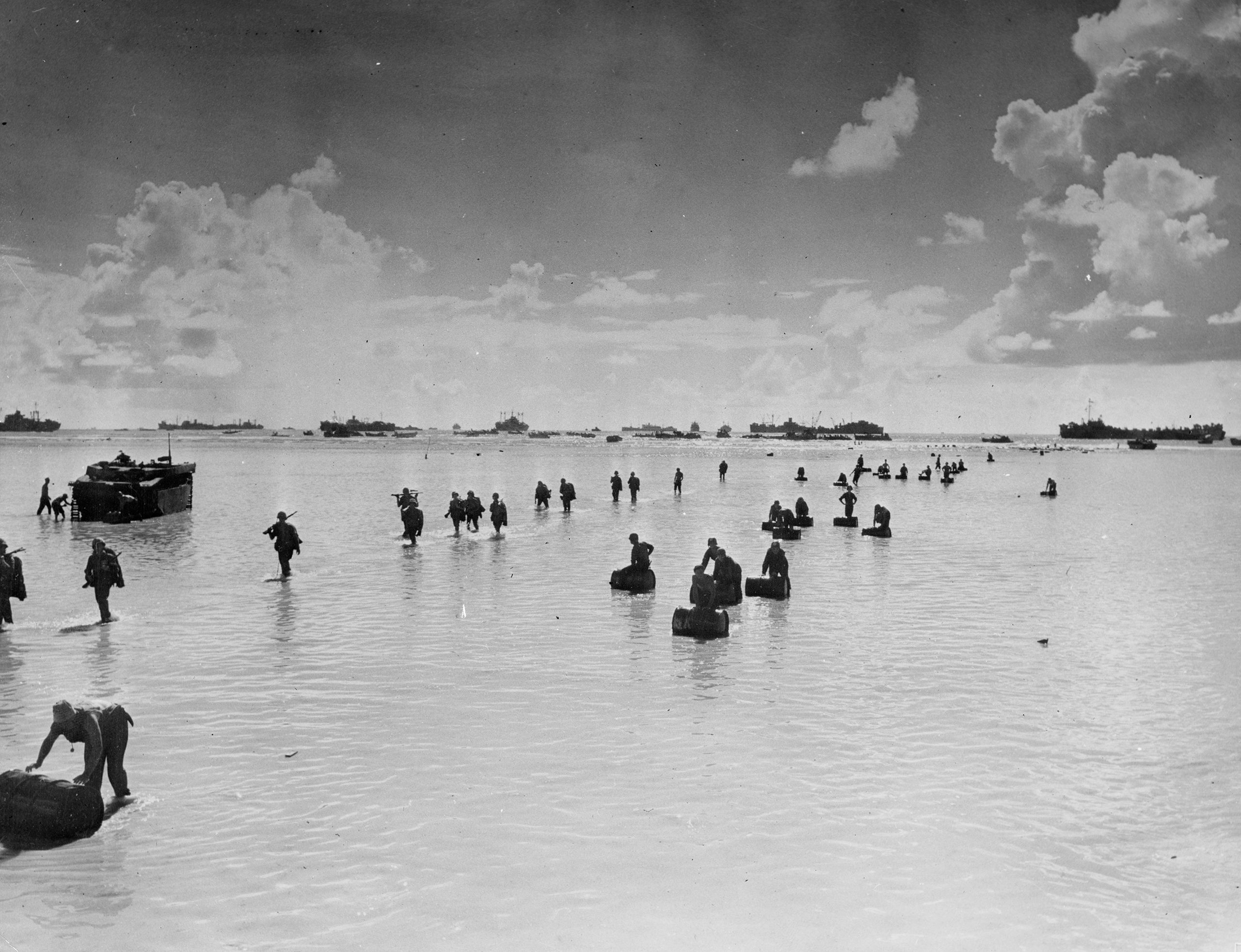
U.S. Marine Corp Captain George P. Shultz. Circa 1945
George Pratt Shultz Papers
, Hoover Institution Archives
U.S. Marine Corp Captain George P. Shultz. Circa 1945
George Pratt Shultz Papers
, Hoover Institution Archives
“…I learned a lot at boot camp and in active duty as a Marine. I remember as though it were yesterday: My drill sergeant hands me my rifle. He says to me, ‘Take good care of this rifle. This is your best friend. And remember one thing: never point this rifle at anybody unless you’re willing to pull the trigger. No empty threats.’ Boot camp wisdom . . . the more people realize that you’re willing to pull the trigger, the less likely you are to have to do it.”
Thinking About the Future, 2019
George Shultz speaking with Hoover Research Fellow Bill Whalen, America and Strategies for the Future (Lessons from the Hoover Policy Boot Camp) | Chapter 1, August 20, 2018. Courtesy of PolicyEd.
George Shultz speaking with Hoover Research Fellow Bill Whalen, America and Strategies for the Future (Lessons from the Hoover Policy Boot Camp) | Chapter 1, August 20, 2018. Courtesy of PolicyEd.
Service as a United States Marine
December 7, 1941: the Pearl Harbor attack killed 2,403 Americans. It also inspired George Pratt Shultz to enlist as a pilot. Poor eyesight, however, sent him back to Princeton to finish his senior year studying economics. But grad school at MIT would have to wait.
Shultz enlisted as a US Marine in October 1942, accepting an appointment as a second lieutenant. He headed off to Quantico for boot camp with the 13th Reserve Officers’ Class and by January 1943 had completed Student Base Defense Section, Artillery Course. He received further training at the Officers’ Base Defense School at Camp Lejune, North Carolina. Then in May he joined AA Group, 7th Defense Battalion, 3d Marine Brigade at Camp Elliot, San Diego, before deploying to the Pacific theater of the war.
After the battle - the Palau Islands - October, 1944
George Pratt Shultz Papers, Hoover Institution Archives
After the battle - the Palau Islands - October, 1944
George Pratt Shultz Papers, Hoover Institution Archives
After first arriving in Upolu, Western Samoa, Shultz saw action at the Nanumea Atoll in the Ellice Islands, was appointed a first lieutenant, and received the additional duty of Commanding Officer, H&S Battery. By mid-1944, Shultz was detached as a battalion liaison officer to the US Army’s 81st Infantry Division for the Battle of Angaur in the Palau Islands, after which he returned to H&S Battery as the Battalion G-2. As the war came to a close in August 1945, Shultz was appointed a captain and returned stateside to the Boston Navy Yard. Now back home, he was able to pick up where he left off—grad school at MIT, where he earned his degree in industrial economics. Major Shultz was honorably discharged in 1957.
Lessons from Chicago
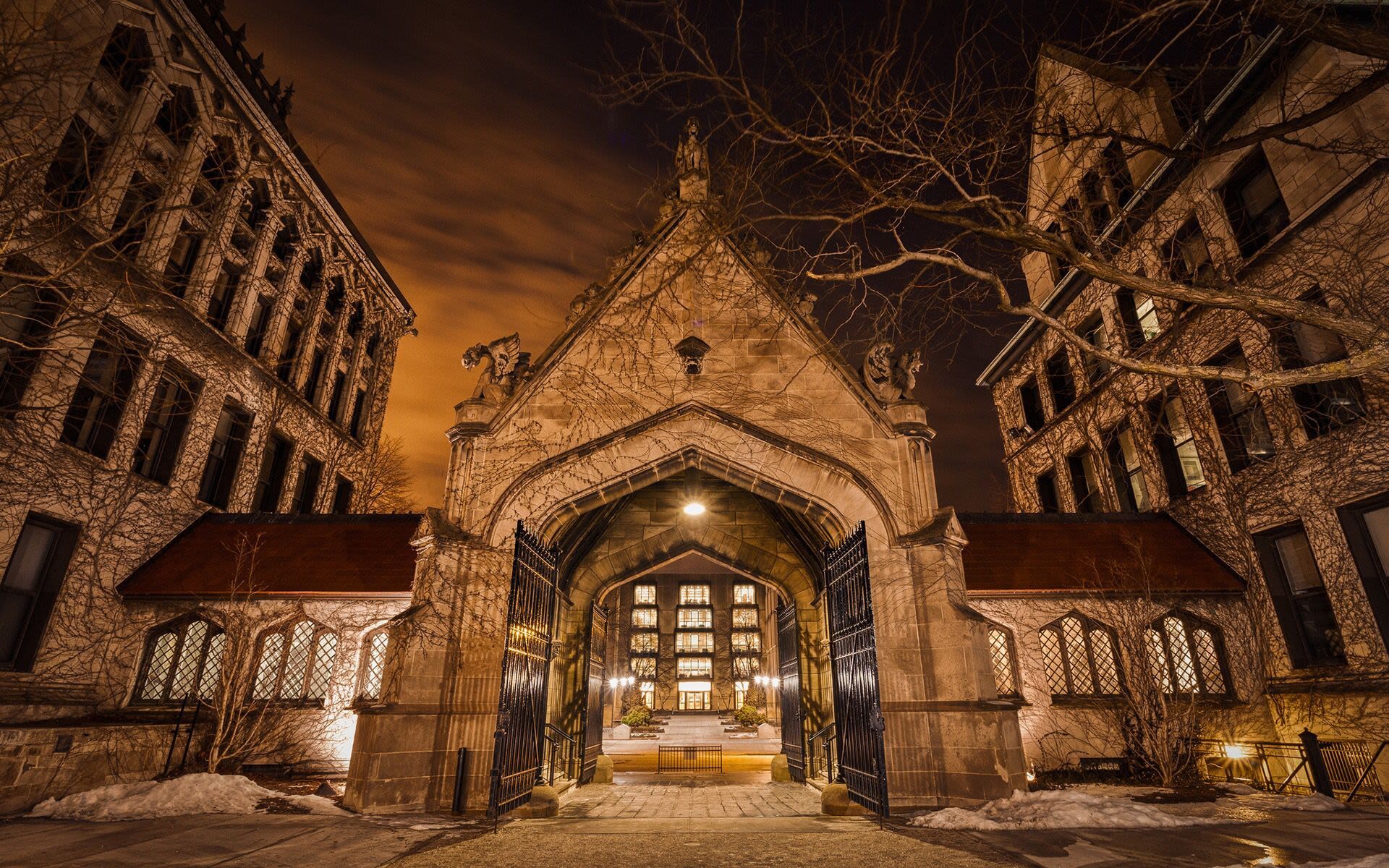
The Chicago School . . . “stands for the fundamental value of freedom, and of course in the economics realm it’s free markets, freedom of enterprise, freedom from undue regulation . . . another attribute of the Chicago School was to always test things. That is, a theory by itself doesn’t cut much ice. You have to test it. You have to get data, empirical data, gather it together, and put it against your ideas to see if the ideas hold up."
Commanding Heights Interview, PBS, October 2, 2000
Image: George Shultz, dean of the Graduate School of Business, at the University of Chicago library, circa 1962.
George Pratt Shultz Papers, Hoover Institution Archives
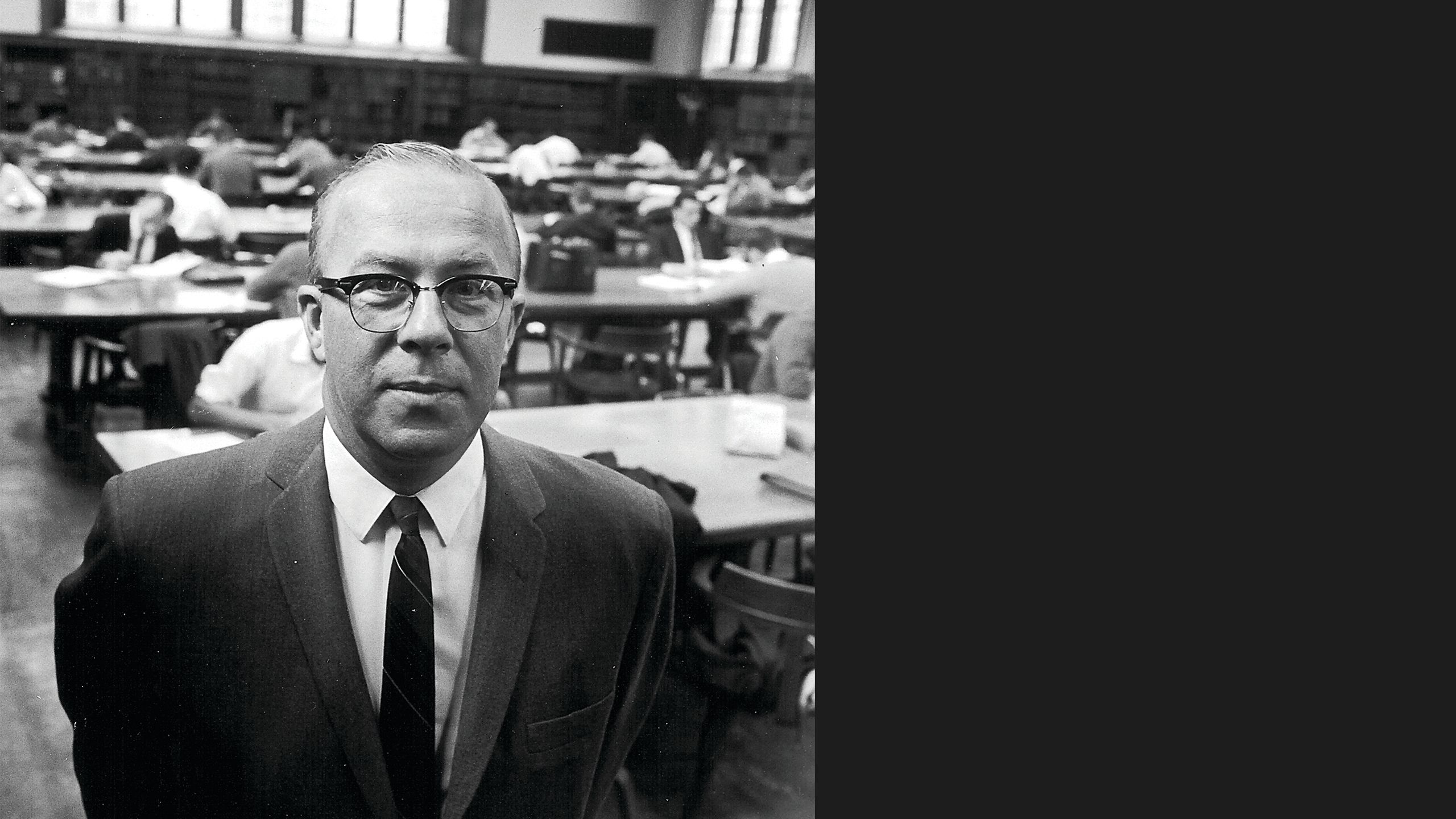
The Economist
Always at his core, George Shultz was an economist. As a professor at MIT after World War II, Shultz dug into labor economics. He learned foundational lessons, such as, “if people are arguing about principle, you can’t get very far, but if you can convert that to an argument about problems, then people are ready to solve problems.” This served him well once in public service, which began with a year on President Eisenhower’s Council of Economic Advisers.
Soon after, Shultz moved to the University of Chicago and eventually became dean of their Graduate School of Business. A powerhouse of economic thinkers, lifelong friendships were forged by Shultz with the likes of George Stigler and Milton Friedman, who would both go on to receive Nobel Prizes. The fun, combative atmosphere of the Chicago School, where collegial arguments were the norm, ignited Shultz’s work and influence.
George Shultz: The Chicago School at Work. Interviewed by Paul Burnett in September 2015.
Oral History Center, The Bancroft Library, University of California, Berkeley.
President Richard Nixon in the Oval Office with economists George Shultz and Milton Friedman. June 1971.
Milton Friedman papers, Hoover Institution Archives
President Richard Nixon in the Oval Office with economists George Shultz and Milton Friedman. June 1971.
Milton Friedman papers, Hoover Institution Archives
The Nixon administration tapped his experience by naming him secretary of labor, then the first director of the Office of Management and Budget, and then secretary of the Treasury. Shultz gained his fourth cabinet seat in the Reagan administration as secretary of state. Regardless of position, however, George Shultz pragmatically returned to his economics experience when facing challenges of any kind. After all, “The free market system is, at its core, a system of accountability,” and “accountability is relentless in punishing bad performances and rewarding good ones”—a key understanding for most diplomatic engagement.
Issues on My Mind: A Vibrant Economy, by George P. Shultz (Hoover Institution Press Book Trailer 04), 2013.
Courtesy Hoover Institution Press
Issues on My Mind: A Vibrant Economy, by George P. Shultz (Hoover Institution Press Book Trailer 04), 2013.
Courtesy Hoover Institution Press
Secretary of Labor George Shultz speaking against imposing wage or price controls to fight inflation. May 28, 1970
George Pratt Shultz Papers, Hoover Institution Archives
Secretary of Labor George Shultz speaking against imposing wage or price controls to fight inflation. May 28, 1970
George Pratt Shultz Papers, Hoover Institution Archives
President Ronald Reagan with his Economic Policy Advisory Board in the Oval Office. 1981 Left to right: Paul W. McCracken, Alan Greenspan, Ronald Reagan, George P. Shultz, and Walter B. Wriston
George Pratt Shultz Papers, Hoover Institution Archives
President Ronald Reagan with his Economic Policy Advisory Board in the Oval Office. 1981 Left to right: Paul W. McCracken, Alan Greenspan, Ronald Reagan, George P. Shultz, and Walter B. Wriston
George Pratt Shultz Papers, Hoover Institution Archives
Margaret Thatcher visiting the Hoover Institution with Milton and Rose Friedman, George and Helena Shultz, and Hoover and Stanford leaders. 1993
George Pratt Shultz Papers, Hoover Institution Archives
Margaret Thatcher visiting the Hoover Institution with Milton and Rose Friedman, George and Helena Shultz, and Hoover and Stanford leaders. 1993
George Pratt Shultz Papers, Hoover Institution Archives
Trust is the Coin of the Realm

Secretary of State George P. Shultz speaking on the importance of trust. Day 34 of the Iran-Contra Investigation, a special Joint Committee Meeting of Congress, July 23, 1987. Courtesy C-SPAN
Secretary of State George P. Shultz speaking on the importance of trust. Day 34 of the Iran-Contra Investigation, a special Joint Committee Meeting of Congress, July 23, 1987. Courtesy C-SPAN
"President Reagan knew that I would tell him what I thought, and he also knew that I knew it was his foreign policy, not mine. So we had good conversations, but underneath it all was trust."
Groundbreaking Diplomacy: An Interview
with George Shultz by James E. Goodby
The Foreign Service Journal, December 2016
“Trust is the coin of the realm.” Regularly spoken by George Shultz, this was a piece of advice received from Bryce Harlow, adviser to Richard Nixon. Harlow knew that this would help sustain the newcomer in Washington, DC, when Shultz began working in the Nixon administration in 1969. It then became a hallmark of who George Shultz would be as secretary of state under President Ronald Reagan, and for the rest of his life.
Shultz had a rare honesty and integrity that made him someone that everyone respected and could work with. From world leaders to Soviet counterparts and even Congressional leaders from across the aisle, politicians continued to look to Shultz for advice and leadership long after leaving public office.
Ronald Reagan and George Shultz at Camp David. August 14, 1982
George Pratt Shultz Papers, Hoover Institution Archives
Ronald Reagan and George Shultz at Camp David. August 14, 1982
George Pratt Shultz Papers, Hoover Institution Archives
President Ronald Reagan congratulating George Shultz on being sworn in as Secretary of State. July 16, 1982
George Pratt Shultz Papers, Hoover Institution Archives
President Ronald Reagan congratulating George Shultz on being sworn in as Secretary of State. July 16, 1982
George Pratt Shultz Papers, Hoover Institution Archives
Soviet Ambassador to the United States Anatoly Dobrynin with George Shultz. April 8, 1986
George Pratt Shultz Papers, Hoover Institution Archives
Soviet Ambassador to the United States Anatoly Dobrynin with George Shultz. April 8, 1986
George Pratt Shultz Papers, Hoover Institution Archives
Prime Minister Tony Blair with George Shultz. July 29, 2006
George Pratt Shultz Papers, Hoover Institution Archives
Prime Minister Tony Blair with George Shultz. July 29, 2006
George Pratt Shultz Papers, Hoover Institution Archives
Secretary of State George P. Shultz greets Crown Prince Akihito of Japan upon the dignitary's arrival for a state visit, Andrews Air Force Base, Maryland. October 7, 1987
George Pratt Shultz Papers, Hoover Institution Archives
Secretary of State George P. Shultz greets Crown Prince Akihito of Japan upon the dignitary's arrival for a state visit, Andrews Air Force Base, Maryland. October 7, 1987
George Pratt Shultz Papers, Hoover Institution Archives
California Governor Arnold Schwarzenegger speaking with George Shultz. June 22, 2009.
George Pratt Shultz Papers, Hoover Institution Archives.
Photo: Michael Mustacchi
California Governor Arnold Schwarzenegger speaking with George Shultz. June 22, 2009.
George Pratt Shultz Papers, Hoover Institution Archives.
Photo: Michael Mustacchi
George Shultz meeting with Chiang Ching-kuo, President of the Republic of China, Taiwan. 1981
George Pratt Shultz Papers, Hoover Institution Archives
George Shultz meeting with Chiang Ching-kuo, President of the Republic of China, Taiwan. 1981
George Pratt Shultz Papers, Hoover Institution Archives
Jiang Zemin, President of the People’s Republic of China, greeted by George Shult in San Francisco, California. October 28, 2002
George Pratt Shultz Papers, Hoover Institution Archives
Jiang Zemin, President of the People’s Republic of China, greeted by George Shult in San Francisco, California. October 28, 2002
George Pratt Shultz Papers, Hoover Institution Archives
George Shultz and Ronald Reagan having fun together in the White House, 1980s
George Pratt Shultz Papers, Hoover Institution Archives
George Shultz and Ronald Reagan having fun together in the White House, 1980s
George Pratt Shultz Papers, Hoover Institution Archives
George Shultz speaking with President George W. Bush. April 21, 2006
George Pratt Shultz Papers, Hoover Institution Archives
George Shultz speaking with President George W. Bush. April 21, 2006
George Pratt Shultz Papers, Hoover Institution Archives
Revolutionary Times
The Power of Ideas
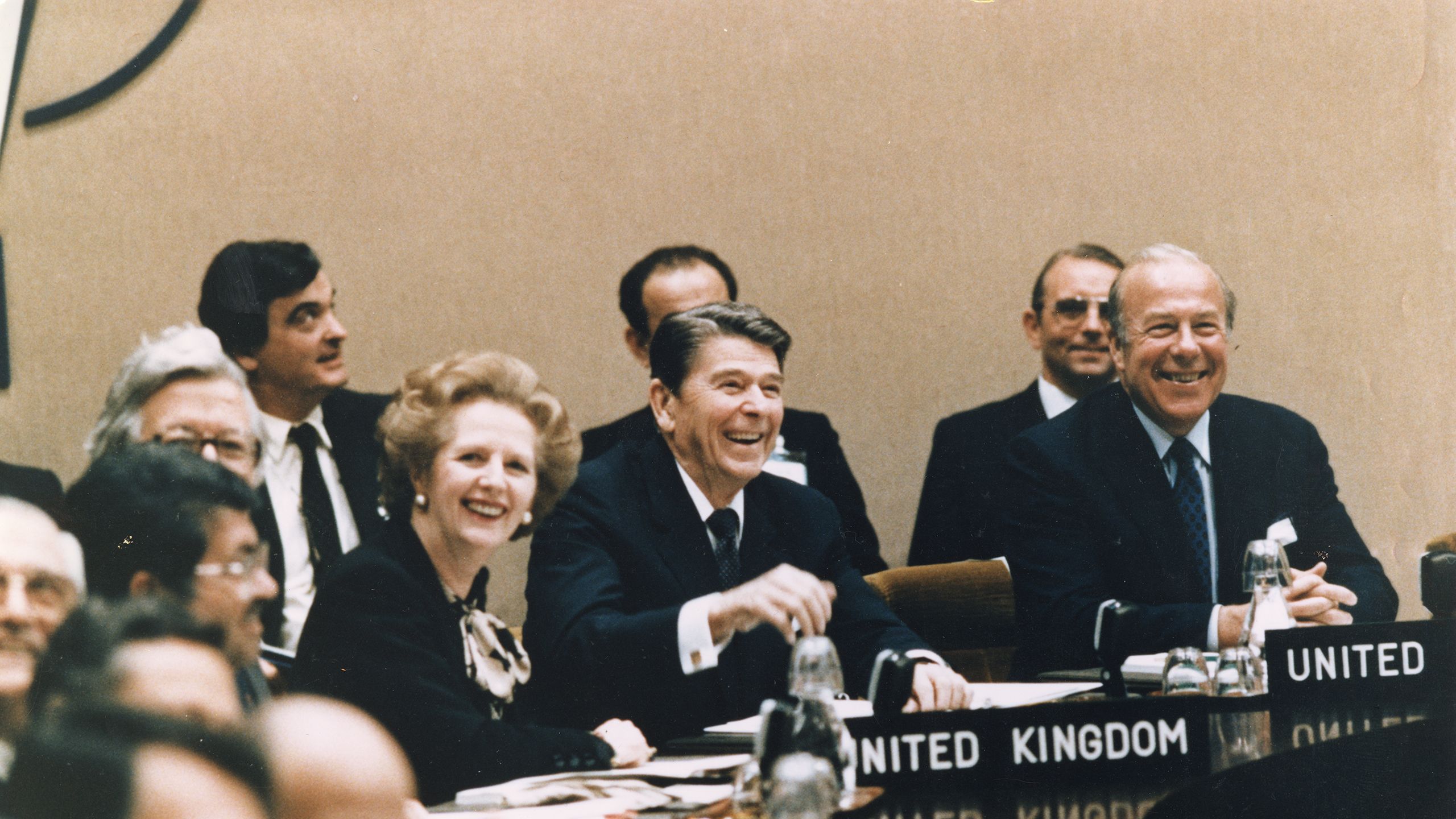
“Lady Thatcher . . . You and Ronald Reagan produced a revolution by the power of your ideas and by your ability to put those ideas into operation. You ended the Cold War, you led the way to the elevation of freedom as an organizing principle in political and economic life, you changed the world and so very much for the better.”
A More Accountable World?,
Address delivered for the 2001 James Bryce Lecture on the
American Commonwealth at the Institute of United States
Studies, London, November 5, 2001.
Image: Secretary of State George Shultz and President Ronald Reagan meet with British Prime Minister Margaret Thatcher in the garden of the Hotel Cipriani in Venice, Italy, during the G7 economic summit. June 9, 1987. George Pratt Shultz Papers, Hoover Institution Archives
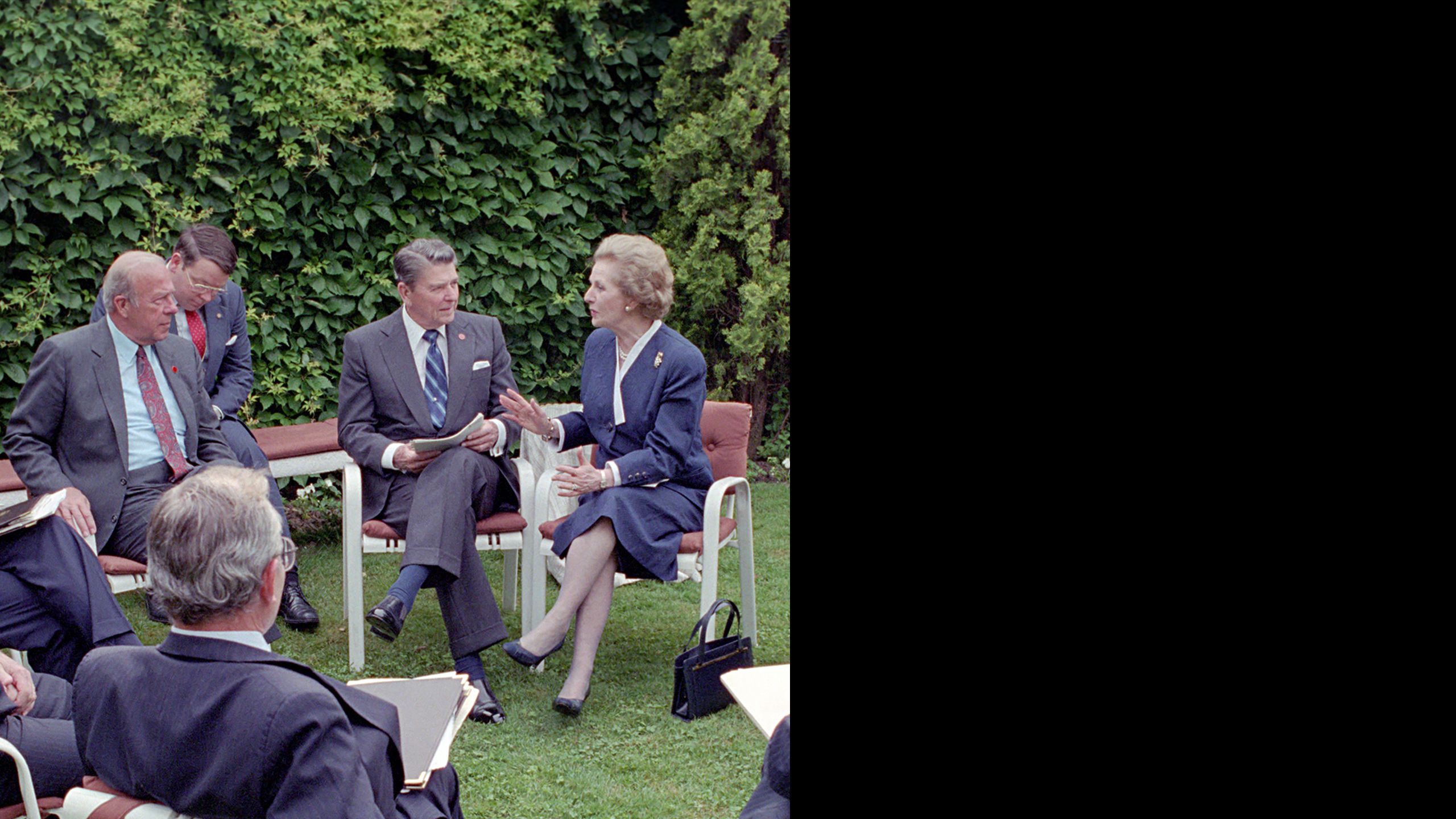
The Cold Warriors
Ronald Reagan became president of the United States in 1981. George Shultz later reflected that at that time “the Cold War is frigid. Inflation is out of control. There is malaise in the economy as described by his predecessor Jimmy Carter. The society is in a state of upset. When [Reagan] leaves, the economy is strong, inflation is under control, steady. The Cold War is all over but the shouting. [Reagan] transformed the situation.”
President Ronald Reagan, speaking in front of the Berlin Wall, declares: “Mr. Gorbachev, tear down this wall!” June 12, 1987.
Courtesy Ronald Reagan Library
President Ronald Reagan, speaking in front of the Berlin Wall, declares: “Mr. Gorbachev, tear down this wall!” June 12, 1987.
Courtesy Ronald Reagan Library
Both Reagan and Margaret Thatcher were to Shultz “idea politicians,” who had strongly held ideas and the convictions to put them into effect. It was through the efforts of those who served under them that diplomacy moved forward to end the Cold War.
George Shultz in Moscow meeting with Soviet General Secretary Mikhail Gorbachev, Soviet Minister of Foreign Affairs Eduard Shevardnadze, and Soviet Ambassador to the United States Anatoly Dobrynin. November 4, 1985
George Pratt Shultz Papers, Hoover Institution Archives
George Shultz in Moscow meeting with Soviet General Secretary Mikhail Gorbachev, Soviet Minister of Foreign Affairs Eduard Shevardnadze, and Soviet Ambassador to the United States Anatoly Dobrynin. November 4, 1985
George Pratt Shultz Papers, Hoover Institution Archives
Over the six-and-a-half years George Shultz served as secretary of state, open dialogue with the Soviets flourished, diplomatic meetings became regular, and agreements were made on human rights, trade, and arms control. Shultz even provided the Kremlin with insight into the coming Information Age and how it would leave closed, compartmentalized societies such as theirs behind. The proof of achievement came in 1989 as the Iron Curtain fell in Eastern Europe.
Clip of George Shultz speaking at the Ronald Reagan Presidential Library's 20th Anniversary Celebration of the fall of the Berlin Wall, January 16, 2009.
Courtesy C-SPAN
Clip of George Shultz speaking at the Ronald Reagan Presidential Library's 20th Anniversary Celebration of the fall of the Berlin Wall, January 16, 2009.
Courtesy C-SPAN
Solidarność demonstration, Kraków, Poland, May 1989.
European Pictorial Collection, Hoover Institution Archives
Solidarność demonstration, Kraków, Poland, May 1989.
European Pictorial Collection, Hoover Institution Archives
Fall of the Berlin Wall, 1989.
German Pictorial Collection, Hoover Institution Archives
Fall of the Berlin Wall, 1989.
German Pictorial Collection, Hoover Institution Archives
Think Big, Act Boldly
On Nuclear Policy

“Proliferation and the potential use of nuclear weapons have once again come to the fore as primary concerns . . . . We need people at the top of key countries who can think big, act boldly, and carry their constituencies with them.”
Reducing the Nuclear Threat: Lessons from Experience,
American Nuclear Society Meeting, November 11, 2013
A Legacy of Nonproliferation
The Intermediate-Range Nuclear Forces (INF) Treaty was signed by Ronald Reagan and Mikhail Gorbachev in December 1987, eliminating an entire class of missiles in Europe. This milestone of the Cold War resulted through the diplomatic navigation of political tension between the Soviet and American superpowers by Secretary of State George Shultz. His policy simplified: encourage Reagan to develop a personal relationship with Gorbachev. Together the leaders looked beyond their own constituencies in order to escape a path of mutual destruction by reducing the stockpile of nuclear weapons.
This same policy continued to be voiced by Shultz and his colleagues in the 21st century. What can be done? Bring together “the best minds of our nations” to cover a range of bilateral security matters, suggested Shultz and Gorbachev. With a precise mission and buy-in from both governments, such a forum could continue the hard work of charting a course for nuclear nonproliferation and expanding dialogue among all nuclear states.
Nuclear Security Project Members, with cofounders George Shultz, Sam Nunn, and William Perry seated at center. n.d.
George Pratt Shultz Papers, Hoover Institution Archives
Nuclear Security Project Members, with cofounders George Shultz, Sam Nunn, and William Perry seated at center. n.d.
George Pratt Shultz Papers, Hoover Institution Archives
Five Fellows United
Sidney Drell, Sam Nunn, Henry Kissinger, William Perry, and George Shultz. These fellows have been at the forefront of discussions on Nuclear Security at Hoover and many international efforts on the topic. Even after the 2016 passing of Sidney Drell, the group continued to pursue a more peaceful and denuclearized world.
This was a driving force for these former Cold Warriors. As a bipartisan group, they met with President Obama in 2009 to address the priorities of nonproliferation and securing loose nuclear materials. However, as Shultz remarked to the press afterward: nuclear weapons are not a bipartisan issue but rather a nonpartisan issue.
William Perry, Sam Nunn, George Shultz, President Barack Obama, and Henry Kissinger meet in the Oval Office to discuss nuclear weapons and nonproliferation. May 19, 2009
George Pratt Shultz Papers, Hoover Institution Archives
William Perry, Sam Nunn, George Shultz, President Barack Obama, and Henry Kissinger meet in the Oval Office to discuss nuclear weapons and nonproliferation. May 19, 2009
George Pratt Shultz Papers, Hoover Institution Archives
Reykjavík Summit. October 1986
From left: General Secretary Mikhail Gorbachev, an interpreter, USSR Foreign Minister Eduard Shevardnadze, President Ronald Reagan, Secretary of State George Shultz
George Pratt Shultz Papers, Hoover Institution Archives
Reykjavík Summit. October 1986
From left: General Secretary Mikhail Gorbachev, an interpreter, USSR Foreign Minister Eduard Shevardnadze, President Ronald Reagan, Secretary of State George Shultz
George Pratt Shultz Papers, Hoover Institution Archives
Hoover Fellows Sidney Drell, Sam Nunn, Henry Kissinger, William Perry, and George Shultz. January 14, 2013
George Pratt Shultz Papers, Hoover Institution Archives
Hoover Fellows Sidney Drell, Sam Nunn, Henry Kissinger, William Perry, and George Shultz. January 14, 2013
George Pratt Shultz Papers, Hoover Institution Archives
Policies Based on Principles
The Hoover Institution
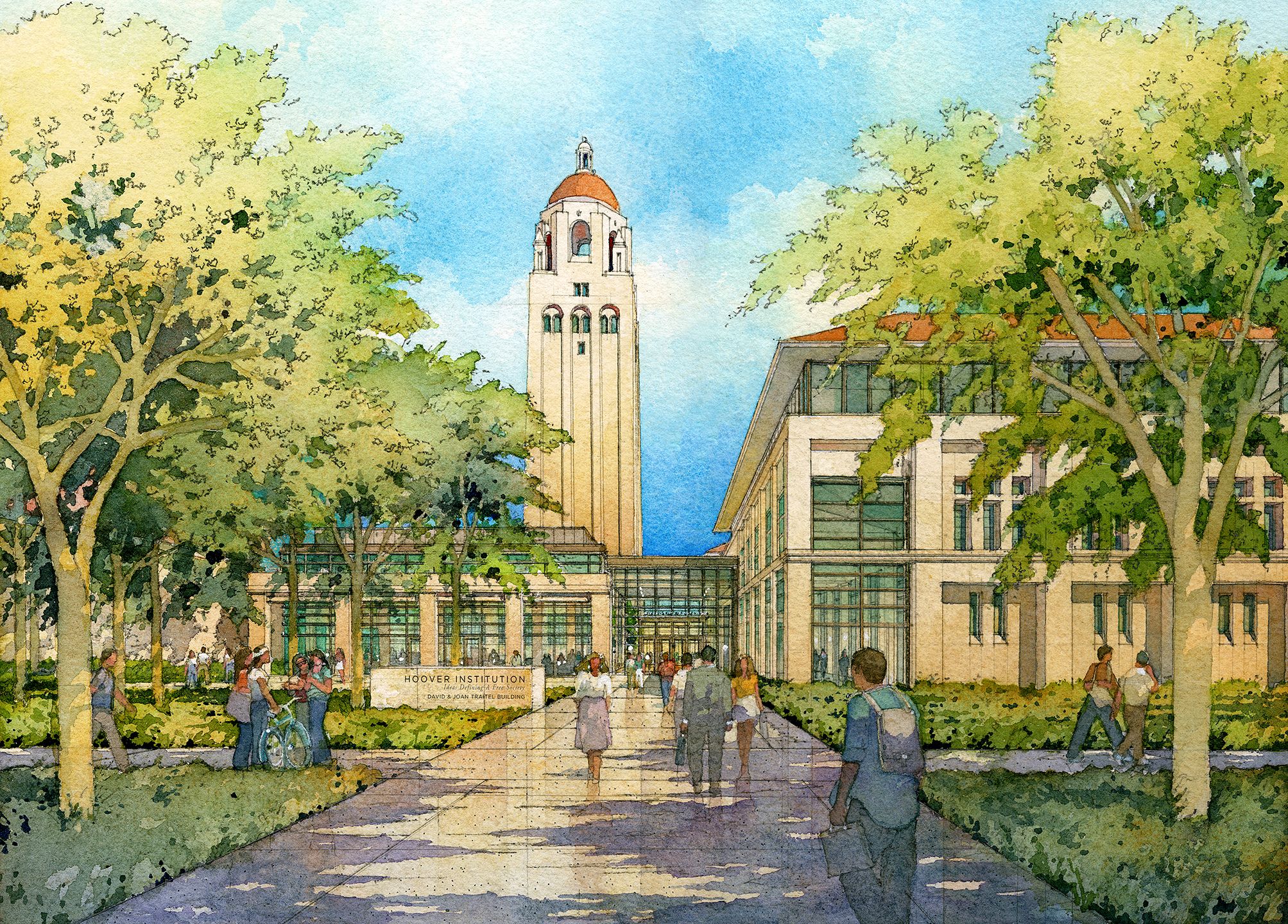
“We are united by a shared commitment to some fundamental principles: tolerance, democracy, equality under the law, and above all, freedom. We have overcome great challenges in our history largely because we have held true to these principles . . . . Our challenge is to forge policies that keep faith with our principles. We know, as the most powerful free nation on earth, that our burden is great, but so is the opportunity to do good.”
Thinking about the Future (2019)
Image: George Shultz speaking at Hoover’s Economic
Recovery Conference. October 14, 2011
Hoover Institution
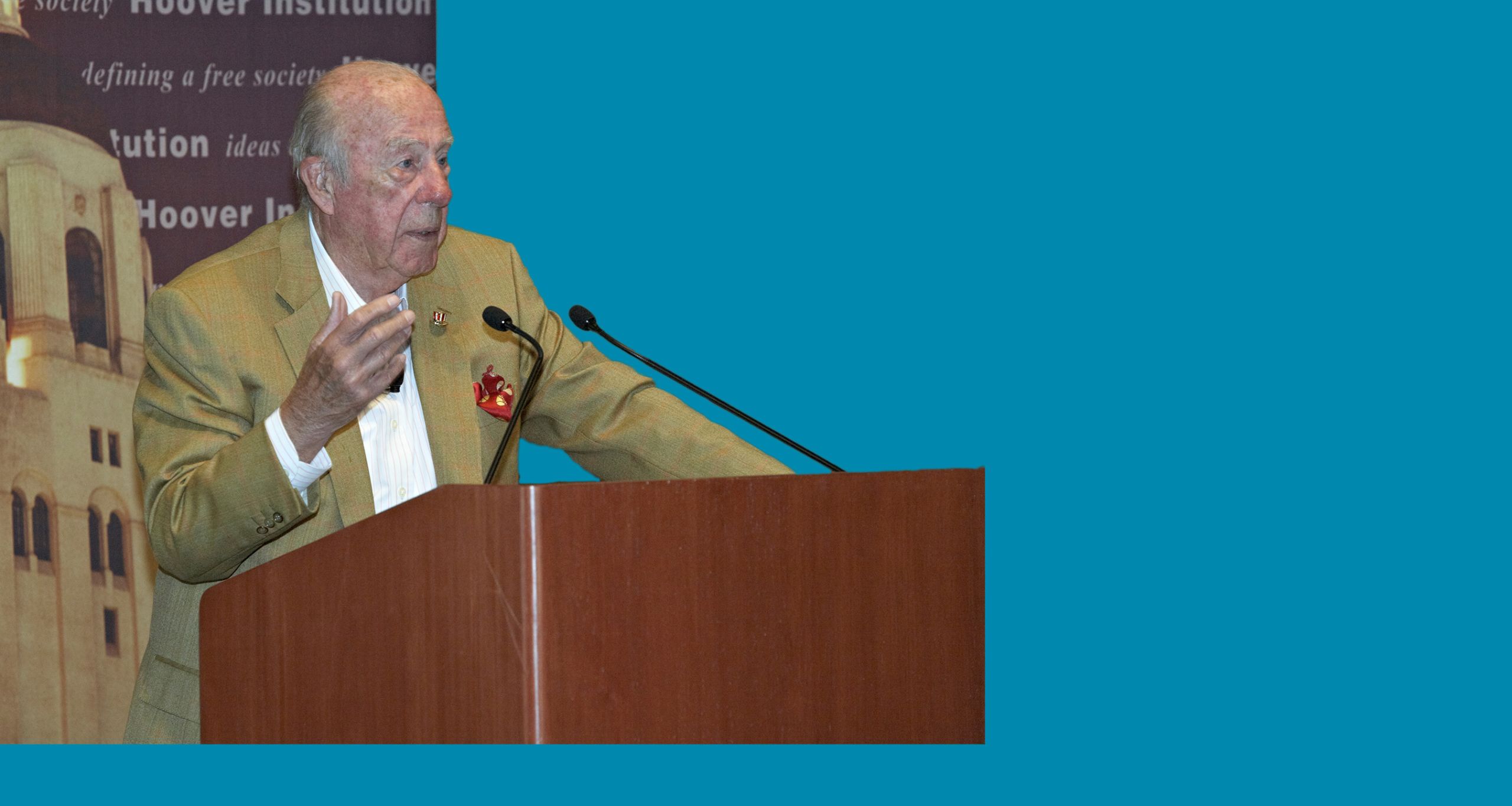
A Distinguished Fellow
After retiring as Secretary of State in 1989, George Shultz returned to California and joined the Hoover Institution. Here Shultz had the freedom and quiet to pen his memoirs about the Reagan administration, Turmoil and Triumph, as well as to dig into the policy dialogues going on among the fellowship.
George Shultz at Hoover, early 1990s.
Hoover Institution on War, Revolution and Peace Records, Hoover Institution Archives
George Shultz at Hoover, early 1990s.
Hoover Institution on War, Revolution and Peace Records, Hoover Institution Archives
He joined task forces to discuss and debate solutions to issues as vast as National Security to Economic Policy, Energy Policy, and Governance in an Emerging New World. As a fellow he authored numerous titles, provided expert testimony to Congress, participated regularly in workshops and found time to share his lifelong passion for public service with the next generation through activities such as the Hoover Summer Policy Boot Camp.
Introduction: American and Strategies for the Future. Recorded August 20, 2018. Courtesy PolicyEd
Research Teams
- Energy Policy Task Force
- National Security Task Force
- Economic Policy Working Group
- Arctic Security Working Group
- Governance in an Emerging New World
- Socialism and Free Market Capitalism: The Prosperity Project Initiative
Attendees at the Hoover Institution’s Foreign Policy Media Roundtable. February 9, 2015.
Photo: Rod Searcey
Attendees at the Hoover Institution’s Foreign Policy Media Roundtable. February 9, 2015.
Photo: Rod Searcey
George Shultz receiving the Medal of Freedom from President Ronald Reagan. January 18, 1989.
“I was proud to receive this honor from him, as we had fought together for the idea of freedom throughout his presidency. We knew that the price of freedom is eternal vigilance and a willingness to act in its defense. We knew that on this matter of principle we could not compromise.”
George Shultz receiving the Medal of Freedom from President Ronald Reagan. January 18, 1989.
“I was proud to receive this honor from him, as we had fought together for the idea of freedom throughout his presidency. We knew that the price of freedom is eternal vigilance and a willingness to act in its defense. We knew that on this matter of principle we could not compromise.”
Former Secretary of State George Shultz testifies before the Senate Armed Services Committee in a hearing on national security strategy alongside Madeleine Albright and Henry Kissinger. January 29, 2015.
Photo: Jay Mallin
Former Secretary of State George Shultz testifies before the Senate Armed Services Committee in a hearing on national security strategy alongside Madeleine Albright and Henry Kissinger. January 29, 2015.
Photo: Jay Mallin
George Shultz speaking as part of Hoover’s Stewart Family Congressional Fellowship Program. April 3, 2018.
Photo: Rod Searcey
George Shultz speaking as part of Hoover’s Stewart Family Congressional Fellowship Program. April 3, 2018.
Photo: Rod Searcey
Making A Difference
Life in Public Service

“I have had an academic career and a business career, both very exciting and worthwhile. But if I look back on my government career, that is the highlight, because I can think back to things I was involved in that made a difference. Really, that’s what your life is about: You are trying to make a difference. And you can do that in public life in a way that is hard to do otherwise.”
Groundbreaking Diplomacy: An Interview
with George Shultz by James E. Goodby
The Foreign Service Journal, December 2016
The Library Group
Shultz’s curiosity and problem-solving nature allowed for his visionary approach to the day’s rules-based world order through projects like his “library group”–an unofficial gathering of senior financial officials from the US, UK, West Germany, Japan and France, that met in the White House library. These meetings led to the formation of the G5.
Years later, Shultz would reflect:
"This close exposure to European leaders and their readiness to work informally and cooperatively impressed on me that I could deal directly with them, that small and frank discussions were desirable, and that people of vision and breadth could be found who could understand positions far wider than those of their own country."
Eye-Opening Moments
There were many special moments for George Shultz when Secretary of State, but few were as eye opening as breaking the sound barrier: “Having donned the special air force suit that inflates and deflates automatically when the speed of the jet changes rapidly, thereby preventing a blackout, I climbed into the rear cockpit of the F-15 Eagle, and we took off–straight up and right through the sound barrier. Lieutenant Colonel Bill Lamb, in the front seat, let me take over once we were well aloft, and I flew the plane for over half the time we were in the air, which made me the “official” pilot on the mission.” -Turmoil and Triumph (1993)
Bipartisan Respect
The success of George Shultz as Secretary of State can be measured in many ways, but perhaps the most telling domestically is a uniquely bipartisan tribute the Senate paid him as he retired from the post.
Senator Ted Kennedy honored the departing Shultz with a special award featuring a crystal tiger approaching a globe. The accompanying photograph of the ceremony that hangs near it in Secretary Shultz's conference room at Hoover today is inscribed by Kennedy with these words:
To Secretary Shultz,
A tiger who burned bright in the eyes of Congress and the World. With respect, Ted Kennedy, Jan 89
Energy & Climate Policy
George Shultz regularly advocated for the need for a balanced approach to energy and climate policy. He encouraged bipartisan constituencies concerned with national security, the economy, and the environment to unite to achieve this.
“We know that we don’t want to be vulnerable to sources of [oil] supply that are uncertain…Every spike in the price of oil has put our economy in a recession…[and] the globe is warming, which is not a matter of opinion, but a matter of fact.”
The Hoover Institution’s Shultz-Stephenson Task Force on Energy Policy explores these subjects in detail and recommends policy initiatives advantageous to both private enterprises and governments.
The Same Small Club
The world continues to benefit from the experiences of George Shultz through his ardent work in some of the toughest arenas of our time. He exercised extraordinary power by negotiating with foreign countries, managing key relationships within the US government, and leading the Department of State. Few stand in the same class as him, though, as Madeleine Albright aptly put it, he is part of the “same small club” of former Secretaries of State that continue their lifelong public service. As Condoleezza Rice once stated, “I believe you never should spend your time being the former anything.” The continued work of George Shultz is a testament to that sentiment, as the policies forged under his guiding flame burn more brightly than ever.
As the new secretary of the treasury, George Shultz “shakes hands” with the first treasury secretary, Alexander Hamilton. 1972
George Pratt Shultz Papers, Hoover Institution Archives
As the new secretary of the treasury, George Shultz “shakes hands” with the first treasury secretary, Alexander Hamilton. 1972
George Pratt Shultz Papers, Hoover Institution Archives
George Shultz ready to pilot the F-15 Eagle. Nellis Air Force Base, Nevada. 1985
George Pratt Shultz Papers, Hoover Institution Archives
George Shultz ready to pilot the F-15 Eagle. Nellis Air Force Base, Nevada. 1985
George Pratt Shultz Papers, Hoover Institution Archives
Senator Ted Kennedy presenting a special award to George Shultz from members of the U.S. Senate shortly before Shultz leaves the State Department. January 18, 1989
George Pratt Shultz Papers, Hoover Institution Archives
Senator Ted Kennedy presenting a special award to George Shultz from members of the U.S. Senate shortly before Shultz leaves the State Department. January 18, 1989
George Pratt Shultz Papers, Hoover Institution Archives
George Shultz speaking with Senator Lisa Murkowski (R-AK), Chair of the Senate Energy and Natural Resources Committee, and Arun Majumdar, co-director of the Stanford Precourt Institute for Energy, during the Stanford Global Energy Forum at Hoover. November 1, 2018
Hoover Institution. Photo: Rod Searcey
George Shultz speaking with Senator Lisa Murkowski (R-AK), Chair of the Senate Energy and Natural Resources Committee, and Arun Majumdar, co-director of the Stanford Precourt Institute for Energy, during the Stanford Global Energy Forum at Hoover. November 1, 2018
Hoover Institution. Photo: Rod Searcey
Members of the “same, small club” of former U.S. Secretaries of State. George Shultz with Rex Tillerson and Condoleezza Rice at Hoover in January 2018, and with Madeleine Albright in May 2000. Inscription reads: To George, I love being in the same, small club with you. All best, Madeleine
George Pratt Shultz Papers, Hoover Institution Archives
Members of the “same, small club” of former U.S. Secretaries of State. George Shultz with Rex Tillerson and Condoleezza Rice at Hoover in January 2018, and with Madeleine Albright in May 2000. Inscription reads: To George, I love being in the same, small club with you. All best, Madeleine
George Pratt Shultz Papers, Hoover Institution Archives
The Hoover Institution continues this online celebration of the 100th birthday of George P. Shultz here:
https://www.hoover.org/research/george-p-shultz-100-celebration
Unless otherwise noted, all collection material shared in this presentation is part of the George Pratt Shultz Papers housed at the Hoover Institution Library & Archives, Stanford University.
The Hoover Institution Library & Archives has placed copies of these works online for educational and research purposes. If you would like to use any of these works, you are responsible for making your own legal assessment and securing any necessary permission. If you have questions about this resource or have concerns about the inclusion of an item, please contact the Hoover exhibits team:Contact Us
For more information about rights and permissions please visit,https://www.hoover.org/library-archives/collections/get-help/right-and-permissions.
© 2021 by the Board of Trustees of Leland Stanford Junior University.
